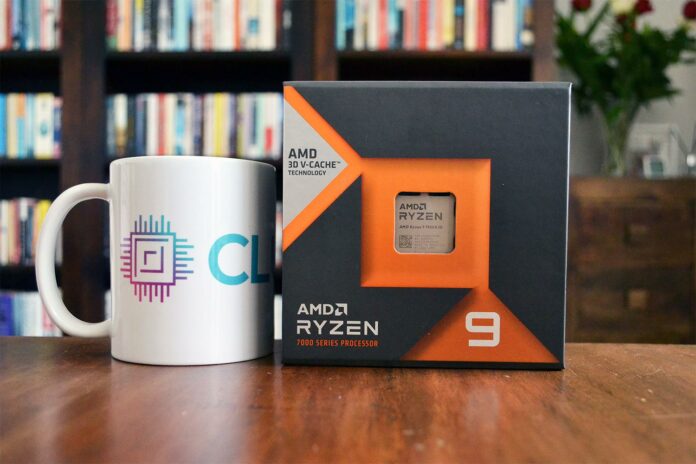Extracting more performance from CPUs is an inherently complicated business. Increasing frequency burns power, going architecturally wider burns die size, jumping down successive manufacturing nodes is damn expensive. Who’d be a CPU lead architect? New problems arise faster than extant ones are solved. Fundamental limitations ought to encroach on step-change improvements from one generation to the next, yet AMD and Intel continue to deliver in spades. Today’s best Ryzen 9 and Core i9 chips smash predecessors from merely three years’ ago. In Darth’s seminal words, ‘impressive, most impressive.’
After traditional levers have been twiddled and optimised to the nth degree, out-the-box thinking is required to increase performance without resorting to the age-old, sledgehammer technique of slamming as much power through the best CPU as possible. AMD believes it has uncovered a gem in X3D technology. First seen on Ryzen 7 5800X3D, the latest 7000 Series range is receiving cache-enriched upgrades to not one but three processors. Ryzen 9 7950X3D and Ryzen 9 7900X3D stride forward today, with Ryzen 7 7800X3D arriving April 6.
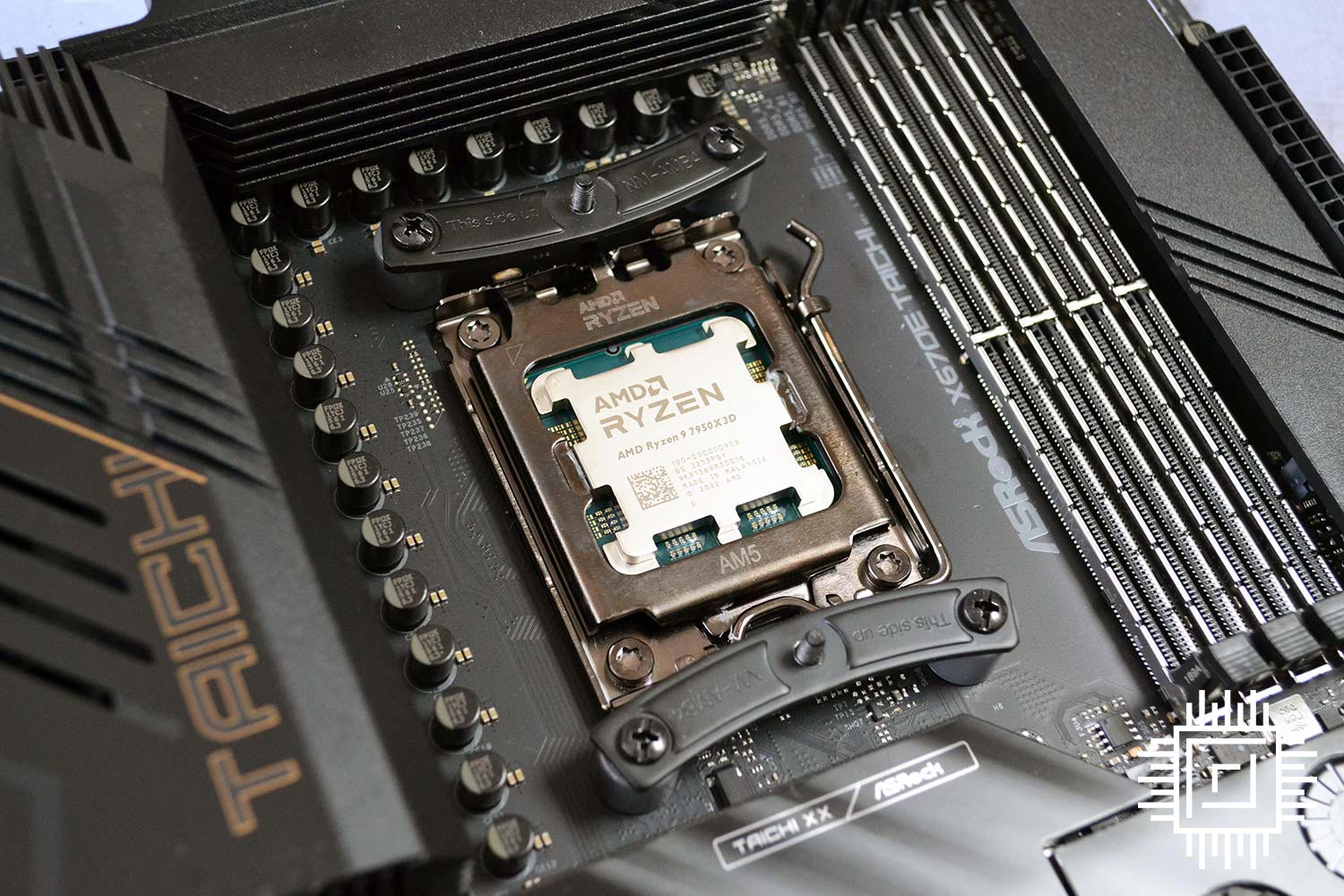

AMD Ryzen 9 7950X3D
£699/ $699
Pros
- Lots of game
- Zen 4 architecture
- Restrained power
- Solid MT performance
Cons
- Multiplier locked
Club386 may earn an affiliate commission when you purchase products through links on our site.
How we test and review products.
Promising massive multi-core muscle alongside class-leading gaming, Ryzen 9 7950X3D deserves serious attention from the well-heeled enthusiast. Let’s first examine high-level specs before drilling down.
How Ryzen 7000 Series X3D Models Stack Up
| Model | Cores / Threads | TDP | L3 Cache | Base Clock | Boost Clock | Launch MSRP |
|---|---|---|---|---|---|---|
| Ryzen 9 7950X3D | 16 / 32 | 120W | 128MB | 4.2GHz | 5.7GHz | $699 |
| Ryzen 9 7950X | 16 / 32 | 170W | 64MB | 4.7GHz | 5.7GHz | $699 |
| Ryzen 9 7900X3D | 12 / 24 | 120W | 128MB | 4.4GHz | 5.6GHz | $599 |
| Ryzen 9 7900X | 12 / 24 | 170W | 64MB | 4.7GHz | 5.6GHz | $549 |
| Ryzen 7 7800X3D | 8 / 16 | 120W | 96MB | TBC | 5.0GHz | $449 |
| Ryzen 7 7700X | 8 / 16 | 105W | 32MB | 4.5GHz | 5.4GHz | $399 |
| Ryzen 5 7600X | 6 / 12 | 105W | 32MB | 4.7GHz | 5.3GHz | $299 |
Adding a trio of cache-boosted chips builds out the Ryzen 7000 Series roster to seven chips spanning $299 to $699. Focussing on the premium segment, Ryzen 9 7950X3D arrives on the scene at the same $699 as the non-X3D launched in November. On the face of it, one can immediately argue AMD is providing value by doing so, but the truth is more nebulous.
Regular Ryzen 9 7950X is now routinely available for $588 with 32GB of DDR5 thrown in in for good measure, providing superb value for a modern CPU. Intel, too, caps maximum price to $689 for rival Core i9-13900KS. Taken with bookends into account, Ryzen 9 7950X3D’s $699 may end up feeling steep.
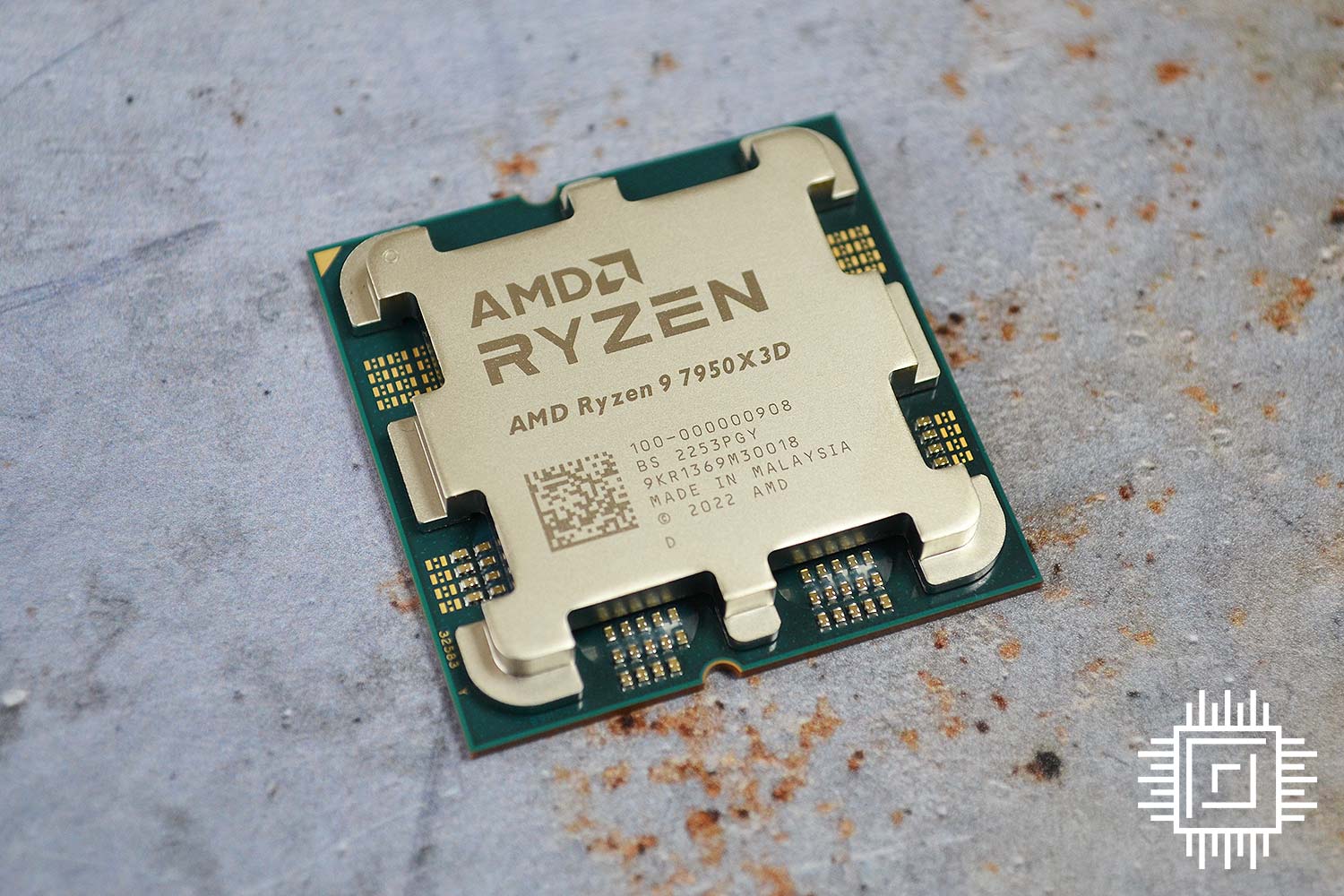
Outside of price, differences exist. Note that whilst the 16-core, 32-thread Zen 4 topology remains intact, AMD rows back on power, from 170W to 120W, suggesting safeguarding of existing models in the stack. Truth be told, reducing available juice is no major performance inhibitor, as proven by a Club386 analysis detailing impressive numbers at 125W and 65W.
Nevertheless, a smaller overall power budget will translate to lower multi-core performance than present on Ryzen 9 7950X, and the impact is detailed in benchmarks below. Yet you’d mostly consider Ryzen 9 7950X3D for heightened gaming availed through adding an extra 64MB of L3 cache, meaning more code resides on the chip itself, rather than being transported over the DDR5 memory subsytem. Let’s now understand how AMD goes about adding further L3 cache.
Stacks of Cache
A proven boon for gaming framerates in particular, there are manifest reasons why chip designers don’t simply add heaps more L3 cache to traditional CPU floorplans. Sure, AMD and Intel could double caches, but doing so would inflate per-chip silicon area to economically and thermally untenable levels. Not to mention travails from associated wiring complexity.
What’s needed is a method of retaining the current silicon footprint and stacking extra L3 on top, in some fashion, without reducing bandwidth, whilst minimising additional access latency. A tall order. Enter 3D V-Cache.
Co-designed with TSMC, AMD uses a technique known as hybrid bonding to deliver unfettered bandwidth from stacked L3. Cited as a ‘breakthrough capability’ by Sam Naffziger, AMD corporate fellow, a direct hydrophilic bond chemically fuses silicon dioxide on the existing L3 and stacked X3D. The hybrid name, constituting both chemical and metallurgical bonds, comes from joining copper to copper.
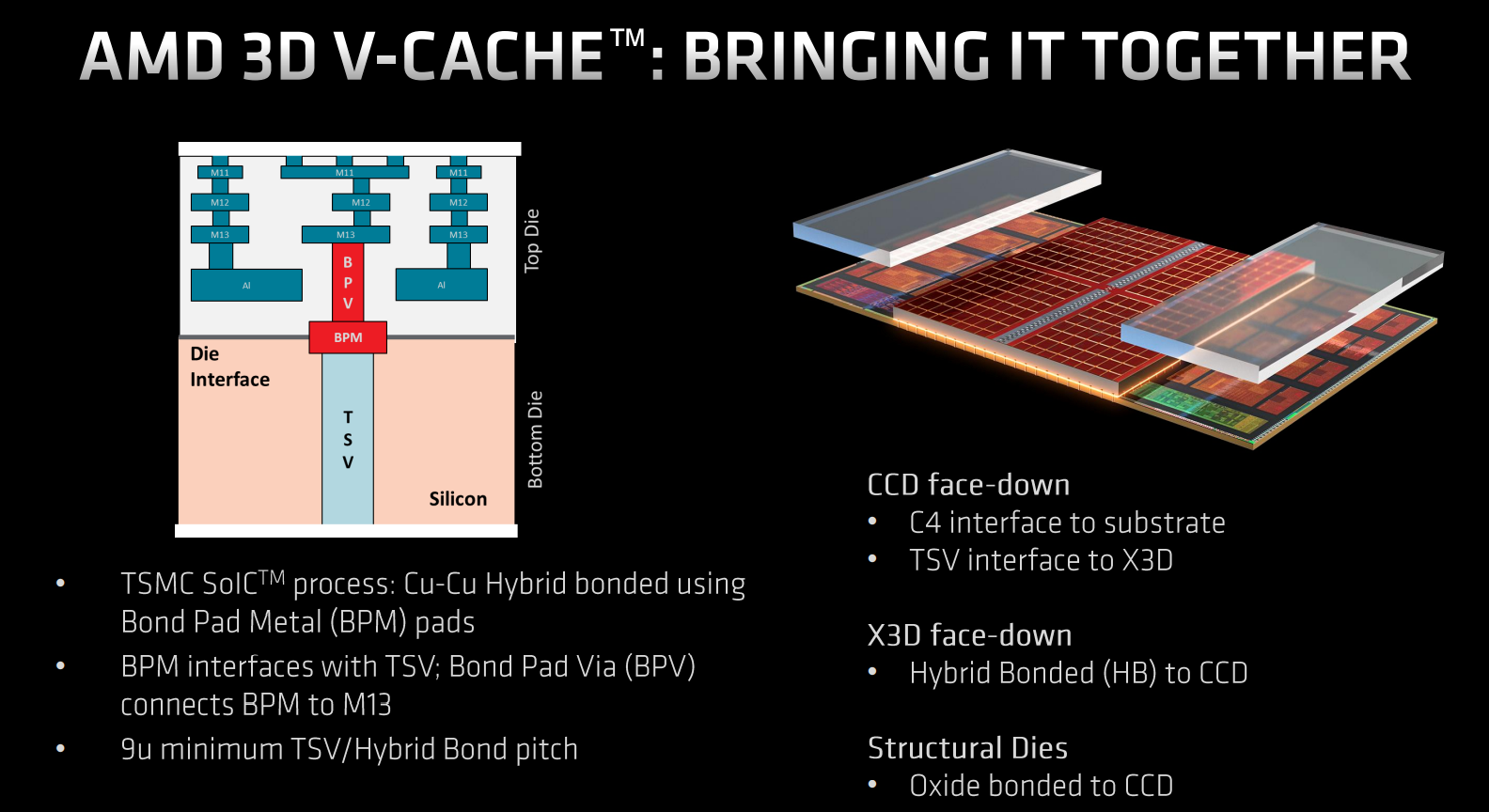
Going down this approach provides ultra-dense layer-to-layer interconnects enabling stacked cache to behave like existing L3. This is possible as the base 32MB of L3 carries dense-enough wiring and a ringbus controller to service any stacked cache. In other words, AMD thought about 3D V-Cache from day one; it cannot be retroactively ported over to other chips lacking TSV transmission support.
In practise, two 32MB L3 stacks are laid on top of existing L3 by connecting through 9-micron TSV pitches at the 13th layer of the top die. Thinking it through, X3D is twice as dense as the base L3 for the same area.
The cores, and by extension operating system, are oblivious to the bonding of extra L3. X3D appears and largely performs like a triple-dense L3 monster. We say largely as there is a minor overhead of four cycles in accessing the upper cache, but that’s a pretty good return all things considered.
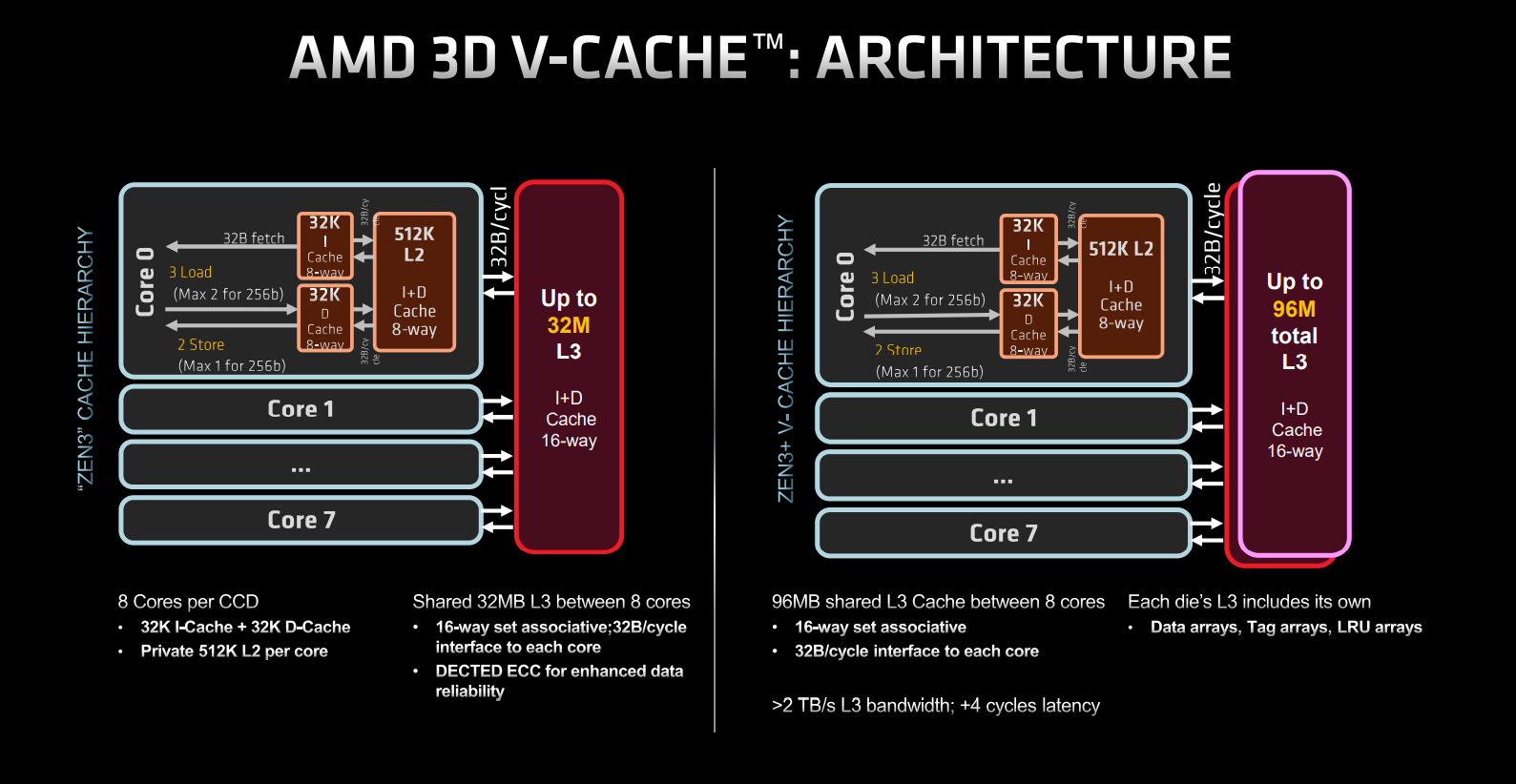
As explained above, regular and X3D chips are only architecturally different from an L3 cache point of view. It’s important to understand that only one of 7950X3D’s two CCD’s is recipient of L3 cache-boosting technology. Now, instead of 32MB per CCD, we have 96MB appearing as one block, while the second CCD, also comprising of eight cores, remains at 32MB, and is otherwise analogous to a Ryzen 9 7950X. The math leads to 96+32=128MB of L3. Should AMD have wanted to, both CCDs can be boosted to 96MB, as it is on select Milan-X Epyc CPUs, leading to 192MB of L3. A future Ryzen X3D chip with increased power profiles, perhaps?
This asymmetrical L3 layout has consequences for dual-CCD chips such as the Ryzen 9 7950X3D and 7900X3D. Putting the right workload on the right CCD is one extra complication of the design. In practise, users want a seamless method of putting cache-heavy workloads – gaming being a prime example – on the 96MB L3 cache-infused CCD and small-footprint code on the regular CCD. It so happens AMD has an answer for this.

The first part is a 3D V-Cache performance optimiser driver that’s included in chipset software 5.01.03.005 or newer. According to AMD, ‘the driver evaluates the performance in real time and dynamically modifies the preferred cores seen by Windows based on workload preference for the 3D V-Cache CCX or the standard die.’ Run automatically for best performance, behaviour can be overridden by the user for manual tinkering.
Furthermore, AMD’s PPM provisioning file driver springs into action when a game is detected. Run on a single CCX by dynamically parking the second CCX, game code takes advantage of the 3D V-Cache technology for improved framerates. If multitasking, however, both CCXes are enabled.
AMD takes these steps to ensure 3D V-Cache is used in the correct instances, for the most impact, but we wonder if there will be times when the two activating technologies might get into a muddle. It’s always better not to have any additional software used, as is the case with single-CCX X3D chips, and we’ll examine how well AMD’s software works in the benchmarking section.
Limited Overclocking
As before, Ryzen 7000 X3D Series chips are multiplier-locked at the factory. That’s a real shame as a large part of AMD’s regular desktop appeal is unfettered access to all facets of performance. Nevertheless, it’s not all bad news, as there’s limited scope to push the chip past out-the-fox frequencies.
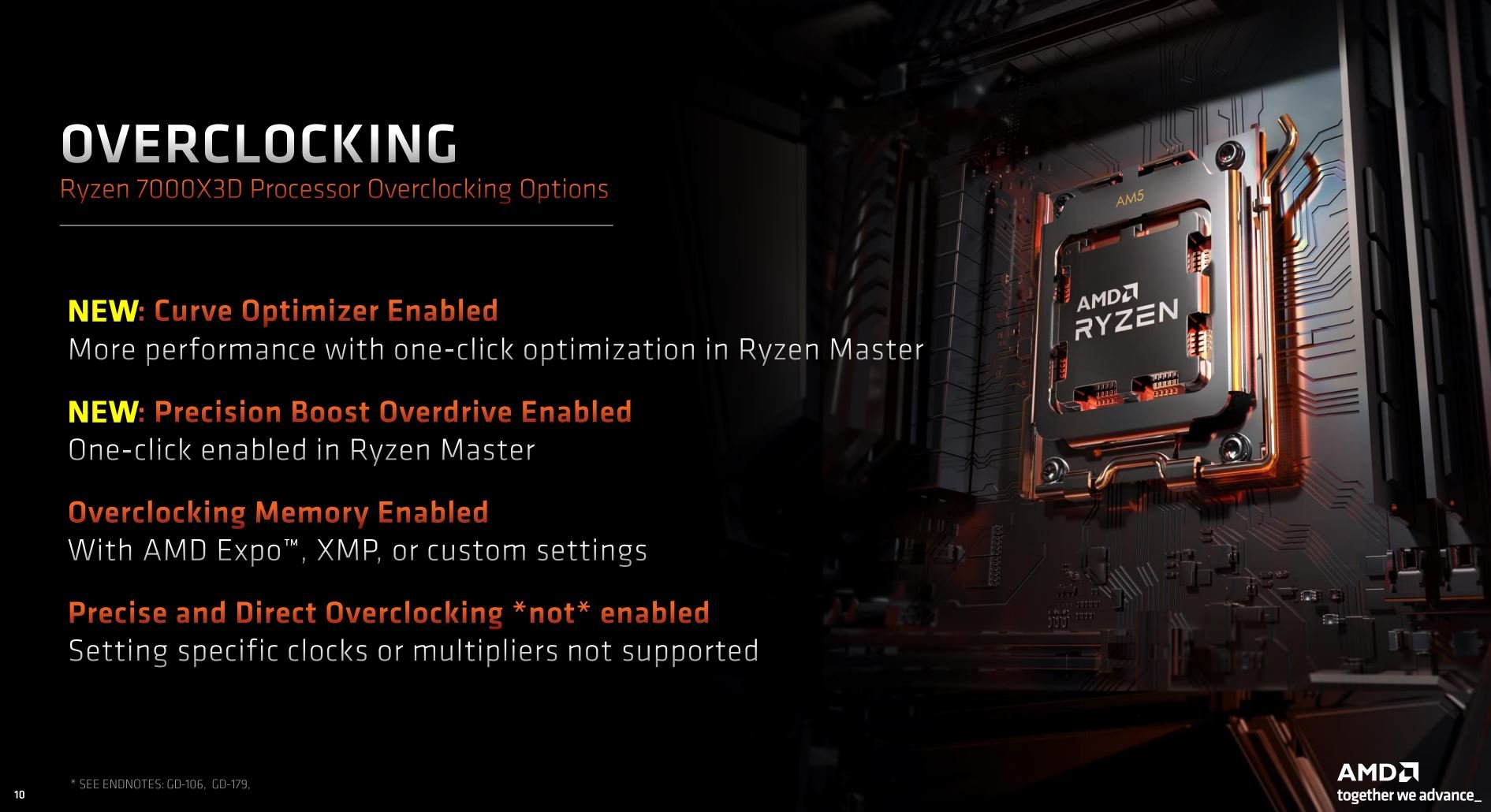
First port of call for any enthusiast is the Ryzen Master software. AMD allows X3D chips to benefit from the ‘Curve Optimiser’ feature, where a little extra headroom is granted by examining the potential of the actual CPU silicon, rather than generic speeds mandated by AMD. Furthermore, whilst being locked in the 120W/142W TDP/PPT mode, Precision Boost Overdrive can also be used to eke out a tad more performance. But it’s only a little, going by AMD’s slides, as the obvious inhibiting factor is locked wattage and voltage.
The Chip
Plenty going on inside, yet nothing new outside. Other than the X3D designation on the spider-esque heatspreader, you cannot tell cache-enriched versions apart from regular AM5 chips.
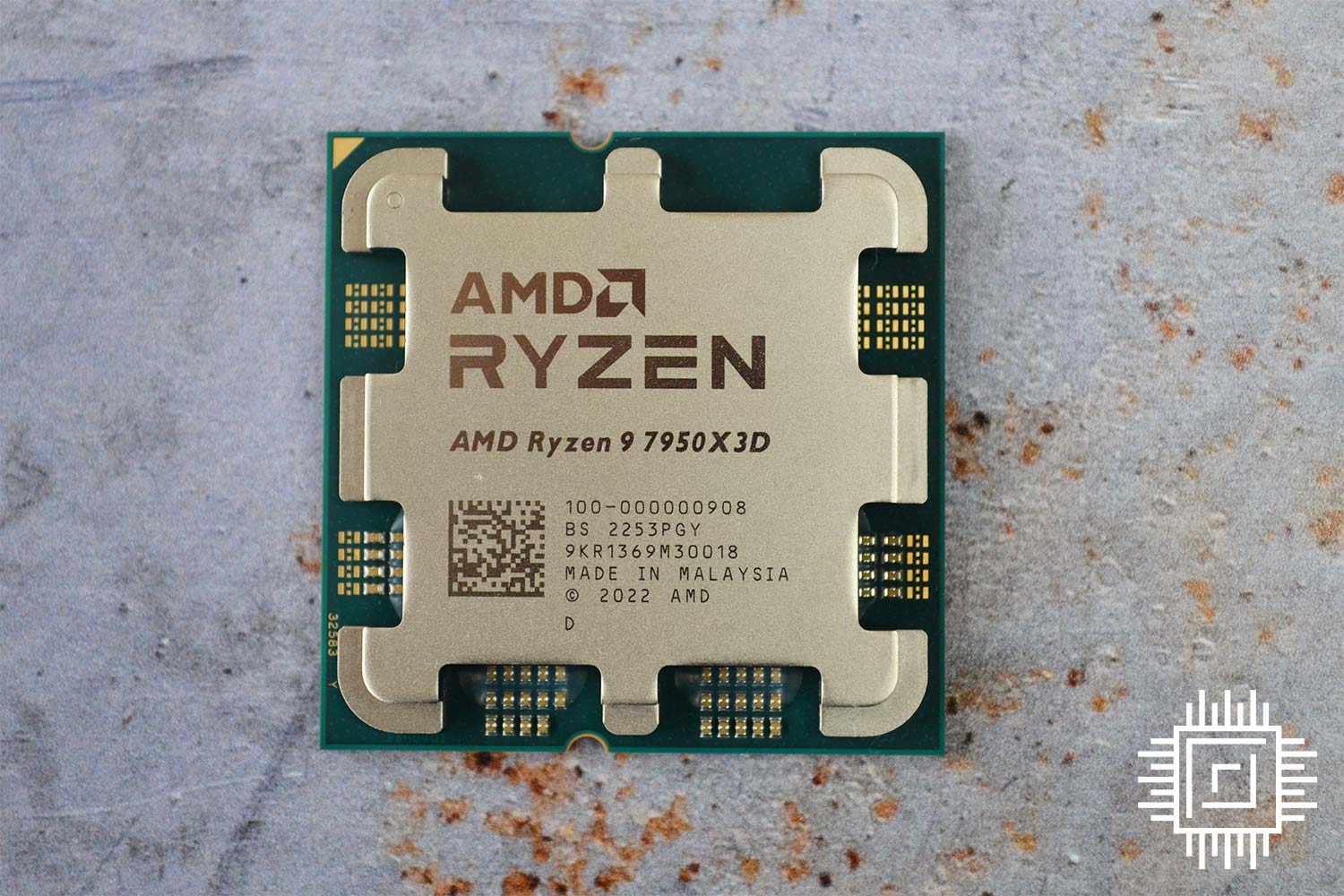
We’re curious as to why AMD restrained power so much when a 170W TDP and associated 220W PPT is fine for 7950X. Is it really a case of ensuring an extra 64MB of L3 cache doesn’t overheat, or is there something more sinister going on? Putting our conjecturing hat on, equipping X3D with the standard 170W TDP would make regular 7950X redundant. Product positioning and all that.
Having a 120W/142W TDP/PPT means Ryzen 9 7950X3D fits into a wider range of motherboards, and even B-series offerings have enough electrical prowess to manage the load easily. Restrained power usually means there’s a cooler in the box, but AMD limits such opportunities to 65W models and below.
Performance
Ryzen 9 7950X3D deserves to be tested on a top-notch motherboard. Enter the ASRock X670E Taichi updated to the latest BIOS and sporting the necessary cache-appreciating driver. Further outfitted with 32GB (2x16GB) of G.Skill Trident Z5 Neo EXPO memory operating at AMD’s official specification, 5,200MT/s, plus Nvidia GeForce RTX 3080 graphics and Noctua NH-D15 cooling, this is premium testing through and through.
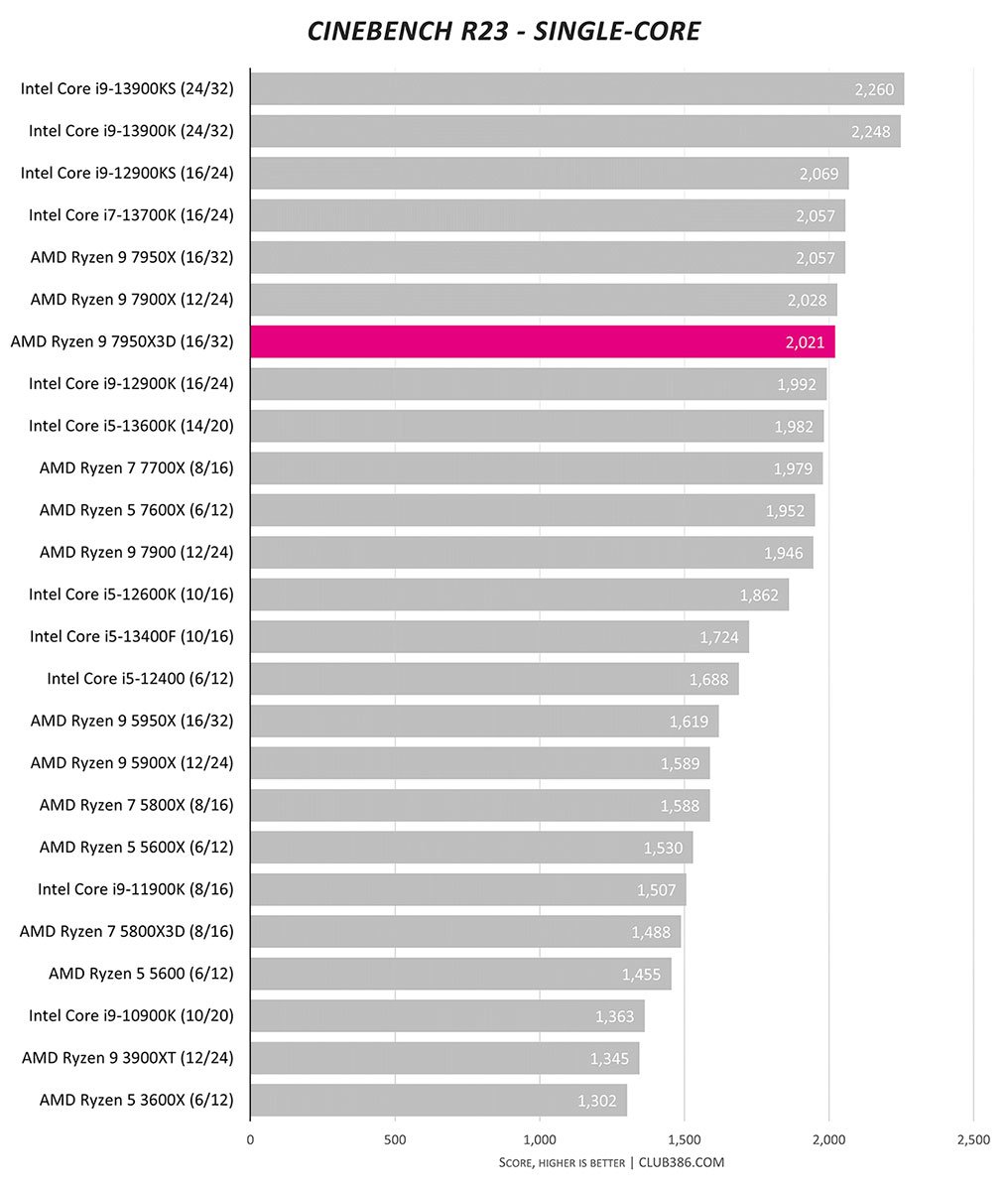
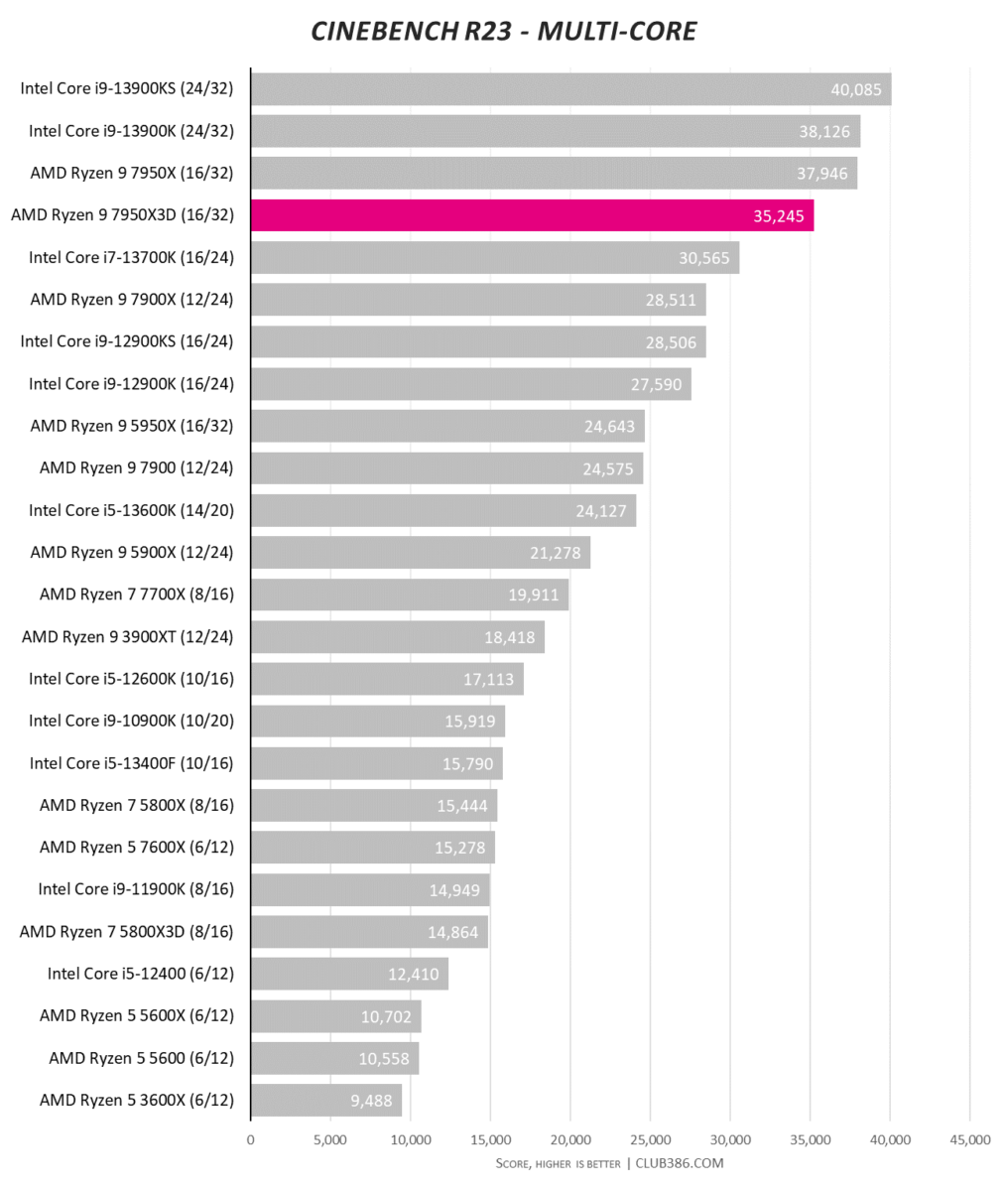
Though the focus ought to rightfully be on gaming performance first and foremost, let’s remember this is a 16-core, 32-thread chip empowered with the full might of the Zen 4 architecture.
Benchmark chops are healthy as a result, and the main reason it’s slower than, say, a Ryzen 9 7950X rests mostly with a lower power budget and final speed. Logs reveal the chip pushing past 5.6GHz when under light load. Put all cores to work and 7950X3D averages around 4.9GHz, but that only tells half the story. Our testing shows the standard CCD to push past 5GHz whilst the cache-enhanced CCD meters effort to 4.8GHz.
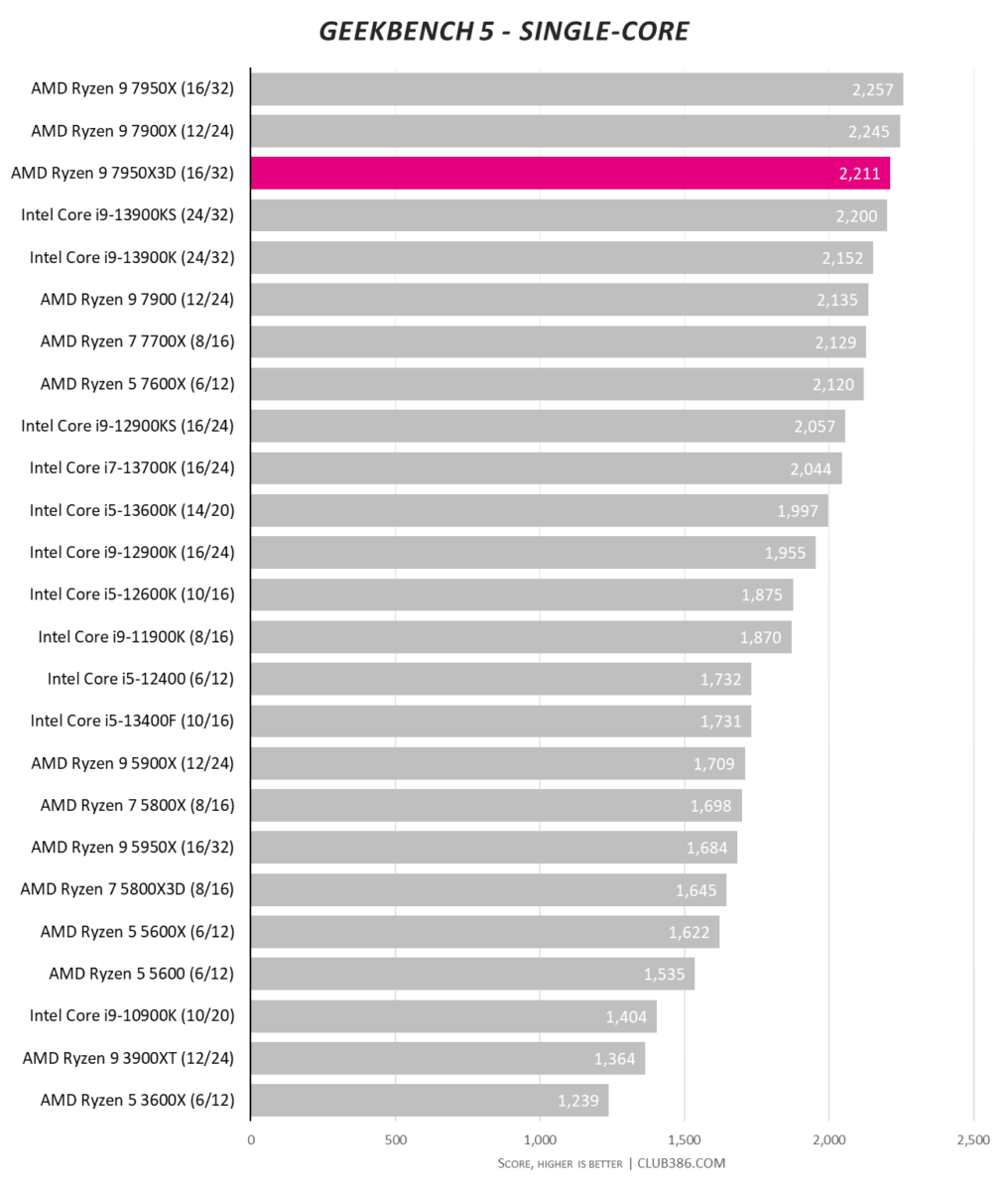
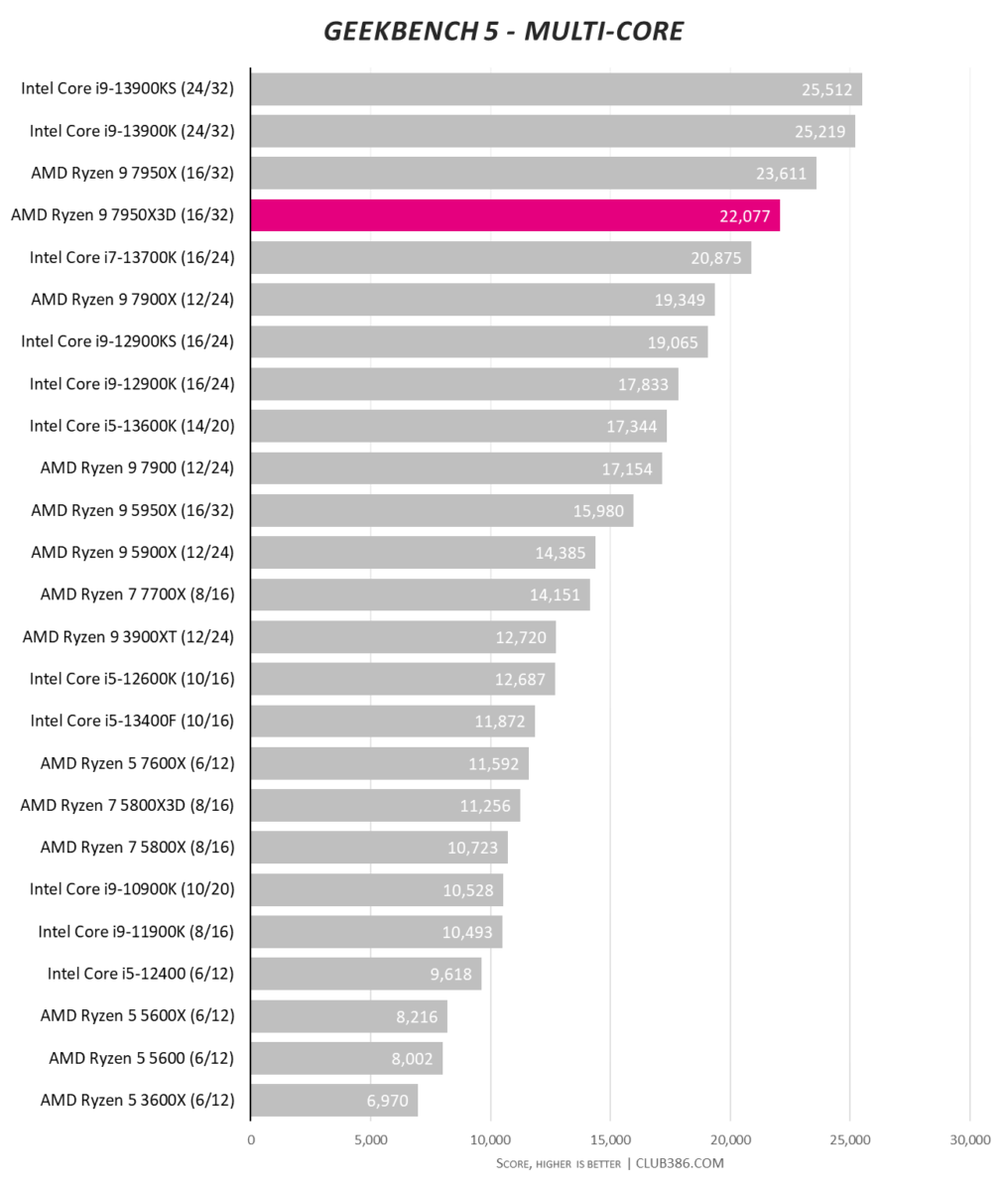
Another solid set of results. Zen 4 has previously shown good aptitude when running at lower wattages; 7950X3D carries on the good work.
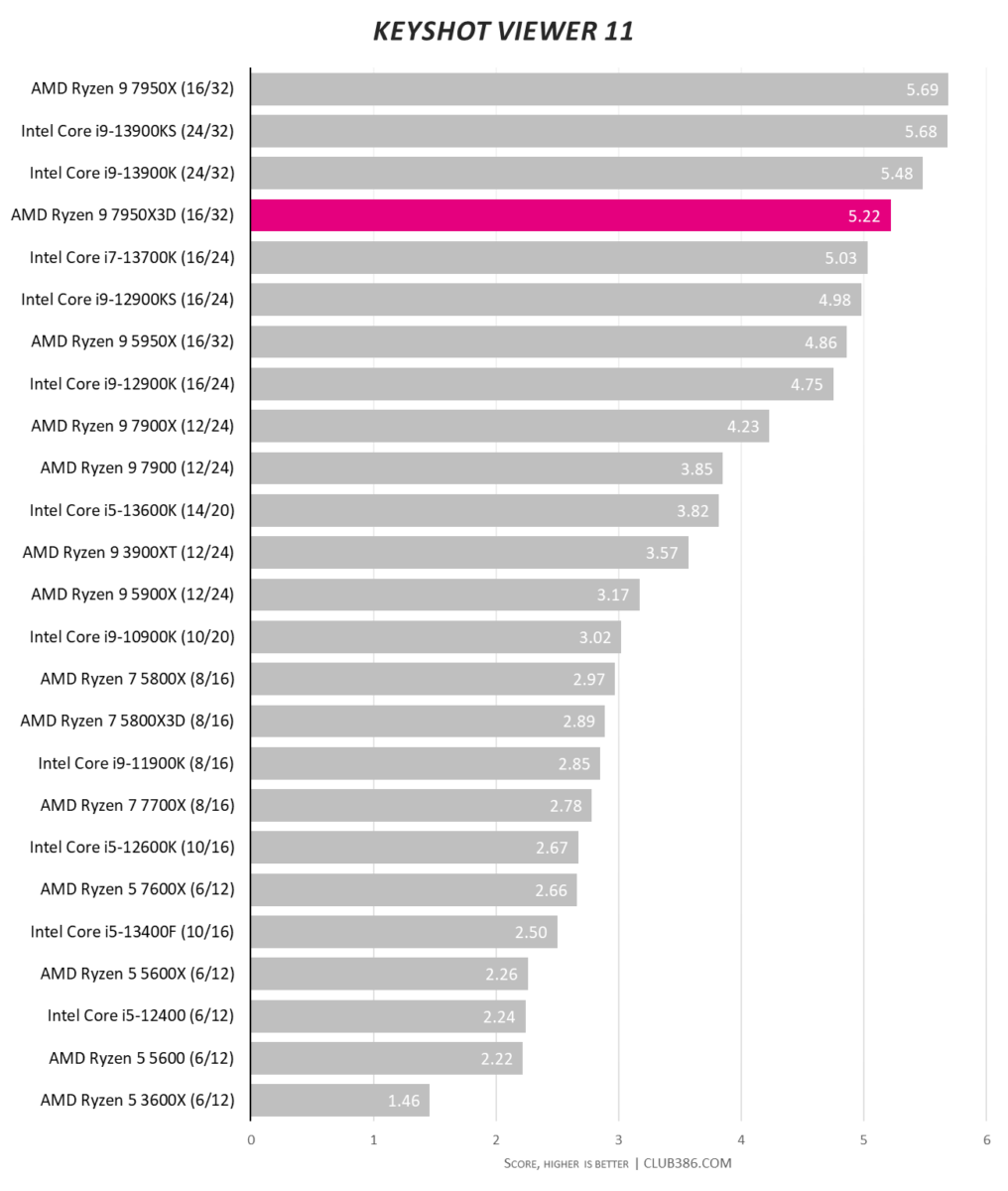
Performance is in line with expectations of a 120W part, though there’s no escaping the fact regular 170W 7950X is the superior chip for demanding multi-threaded work.
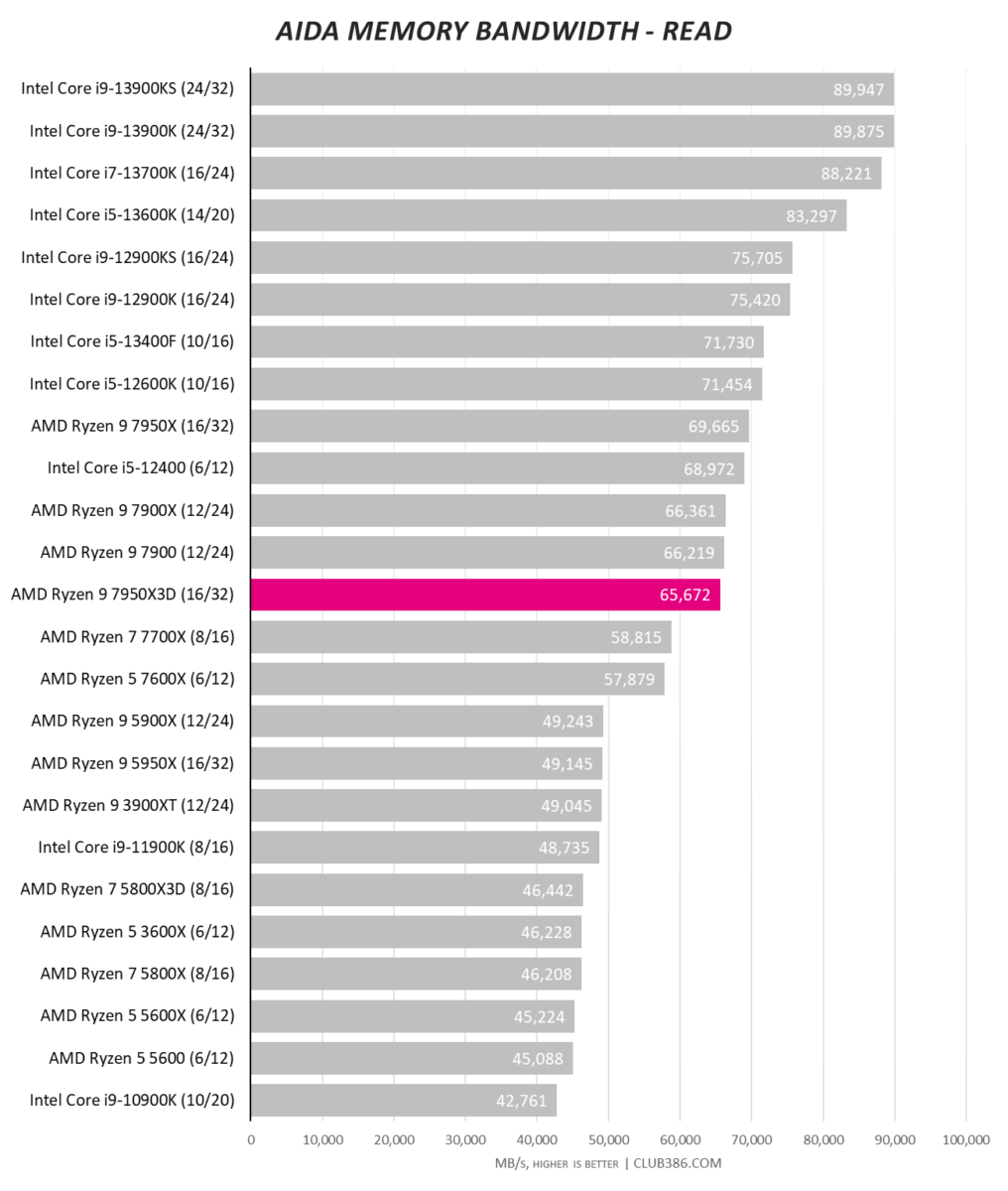
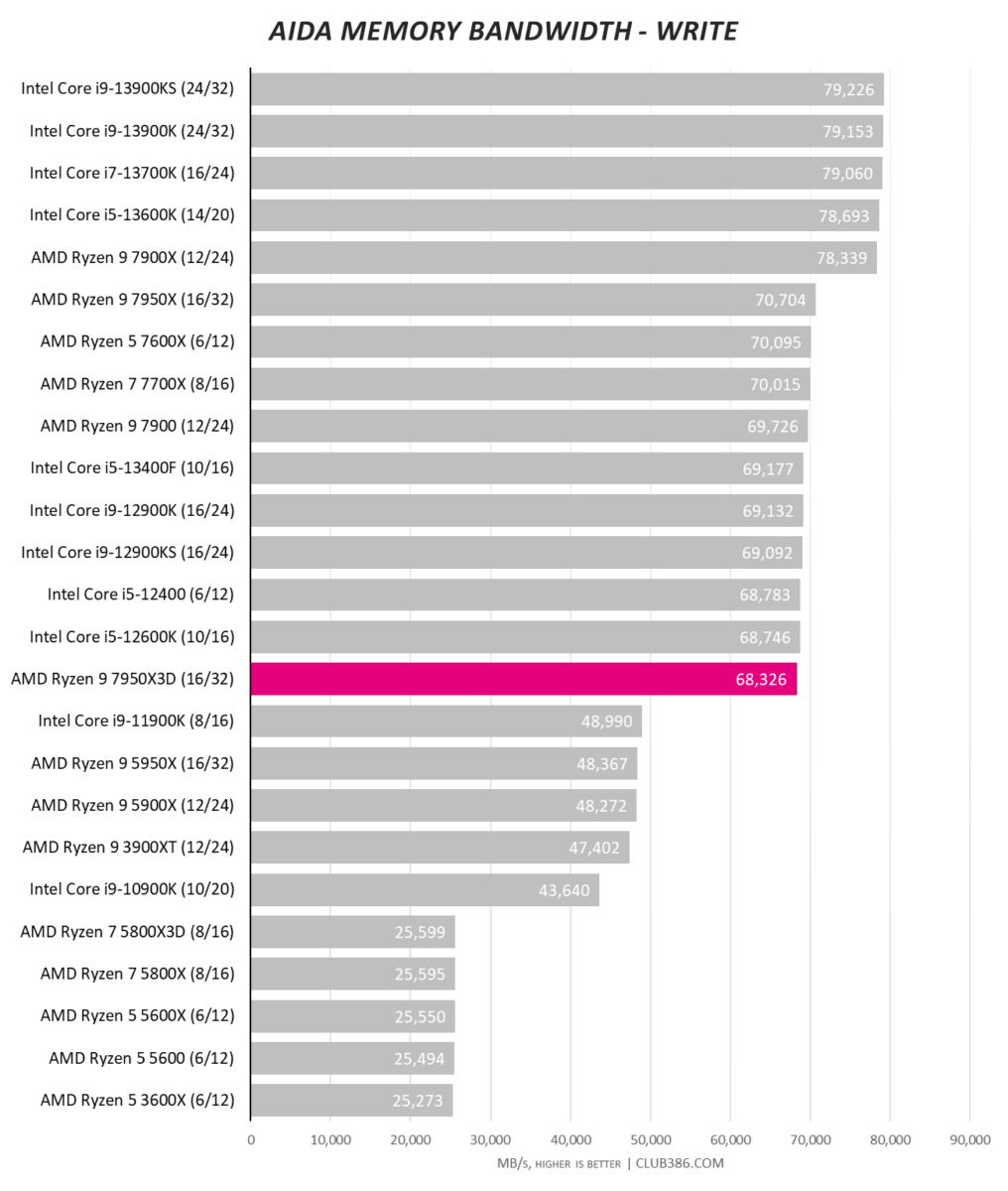
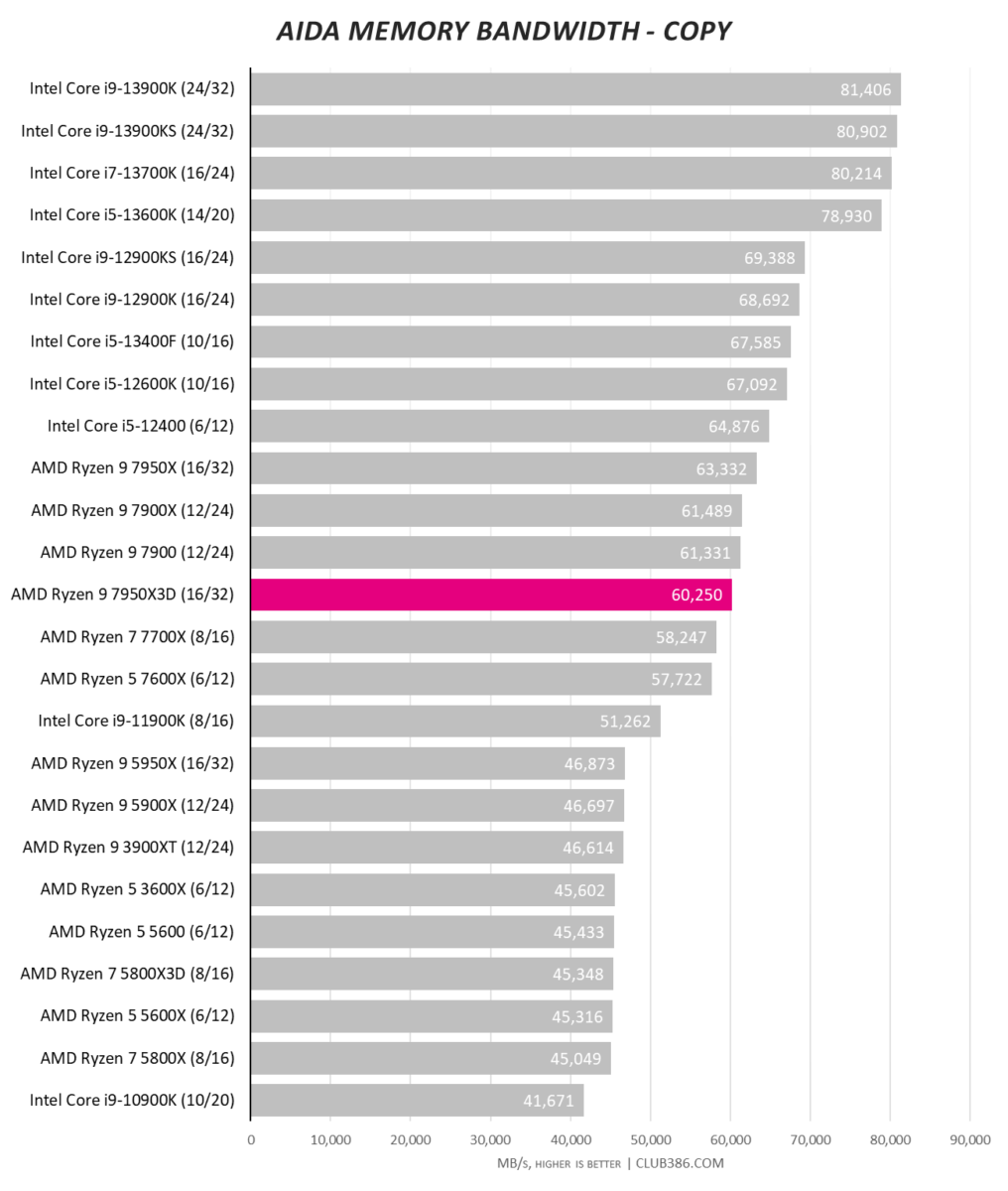
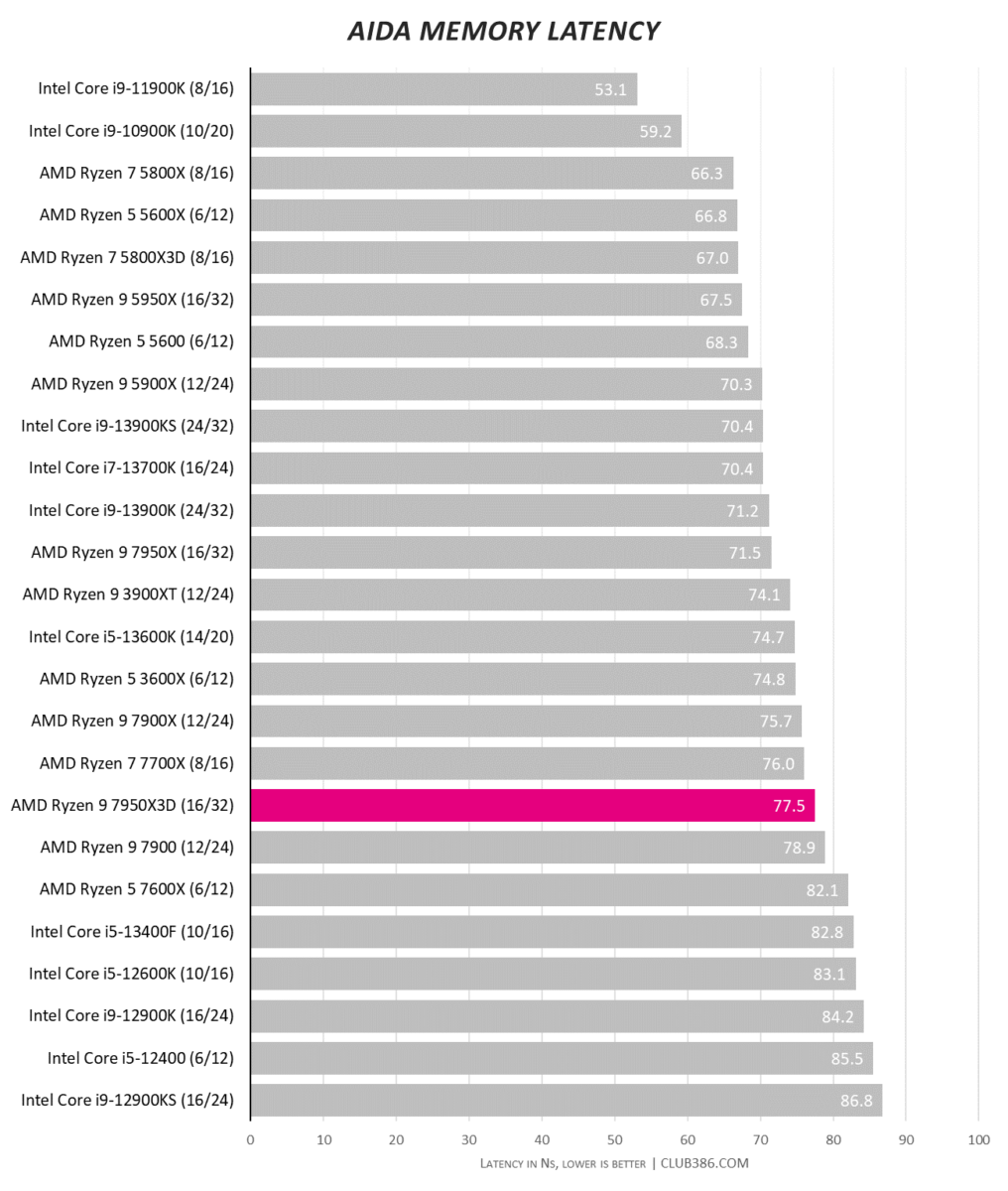
No surprises in the memory department. The regular AIDA test doesn’t readily differentiate between CCDs so we can’t calculate the extra latency of hopping on over to X3D.
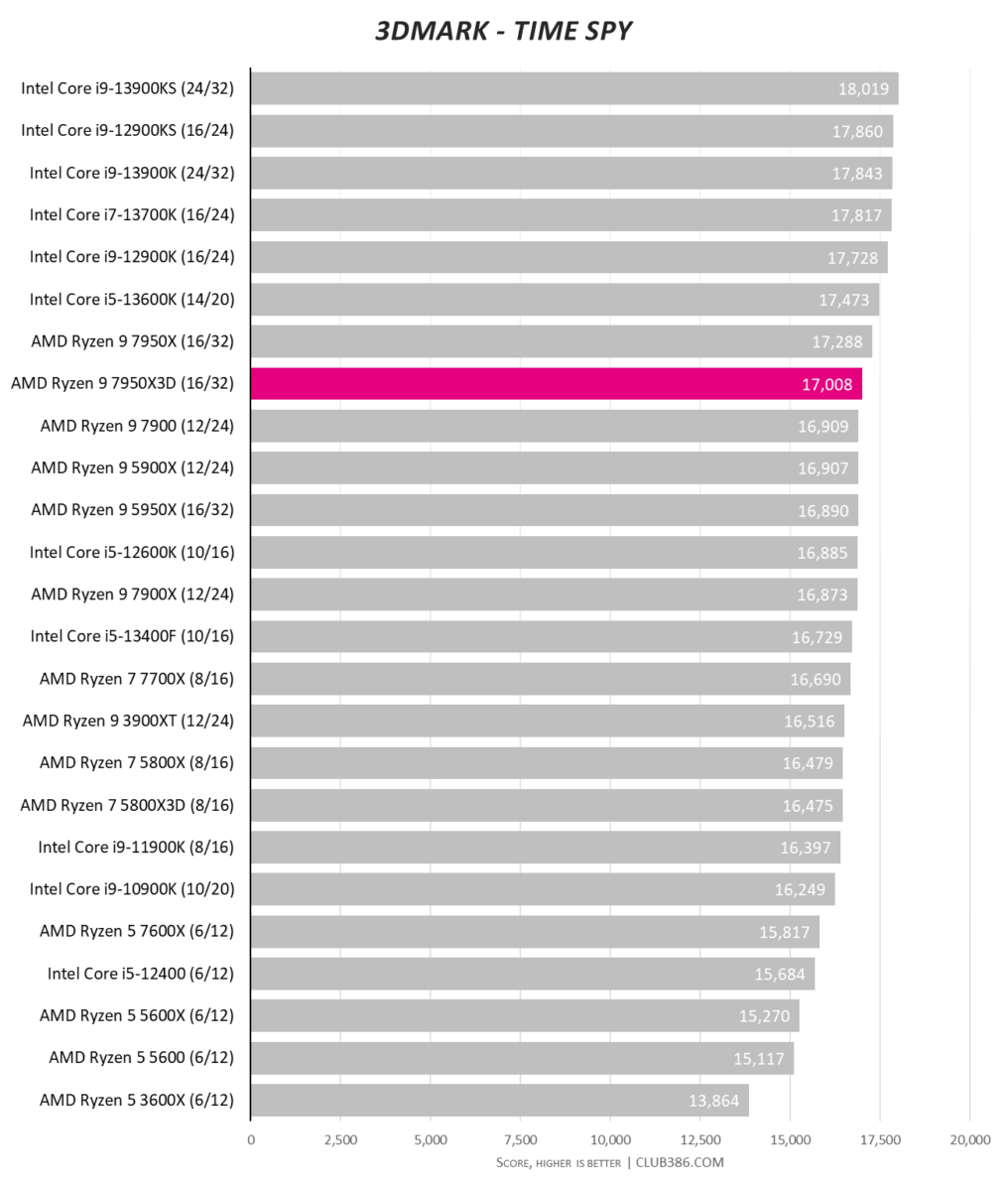
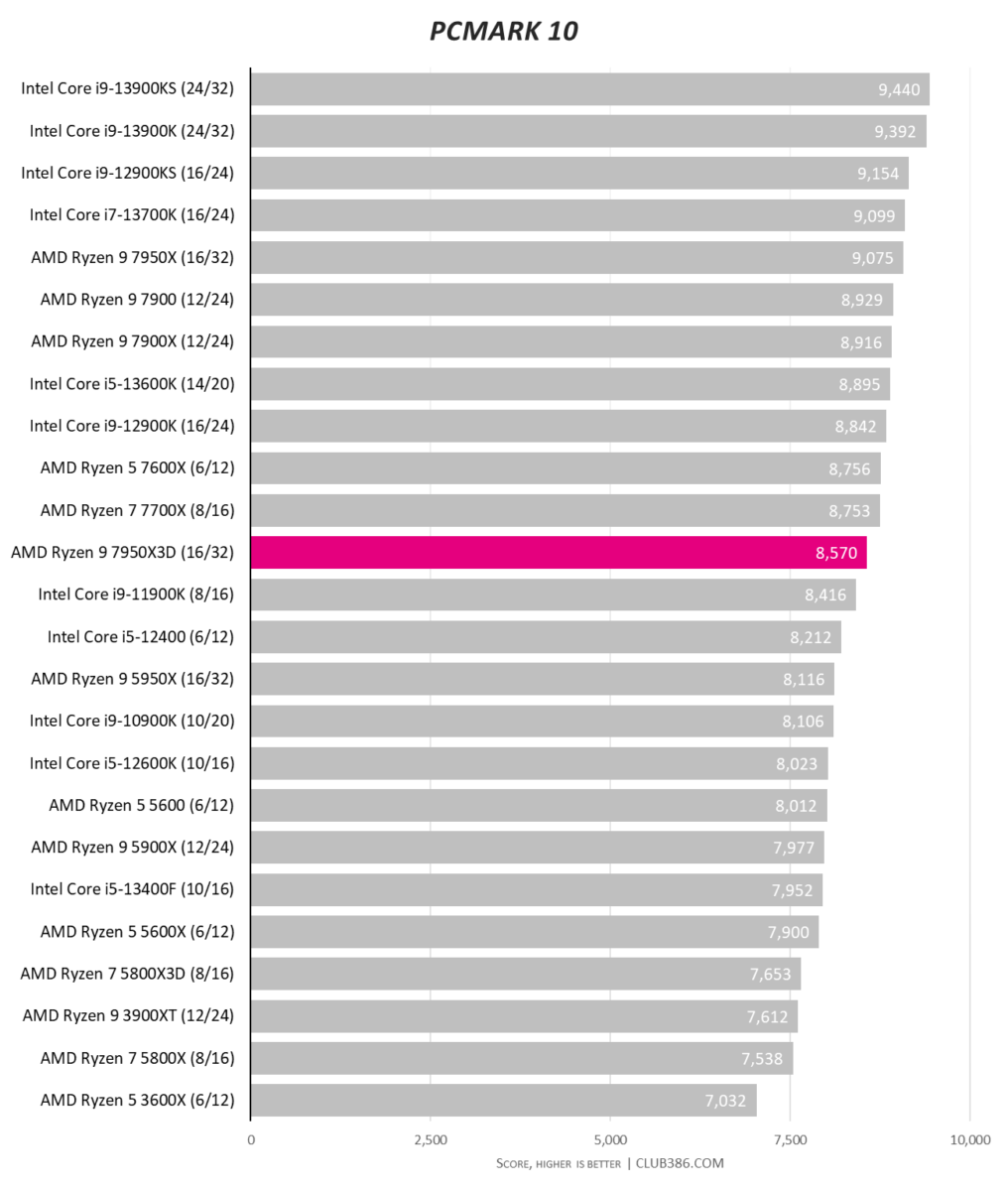
System scores are middling more than impressive, as these synthetic tests rely heavily on peak frequency. Surely it’s real games that count…
Gaming
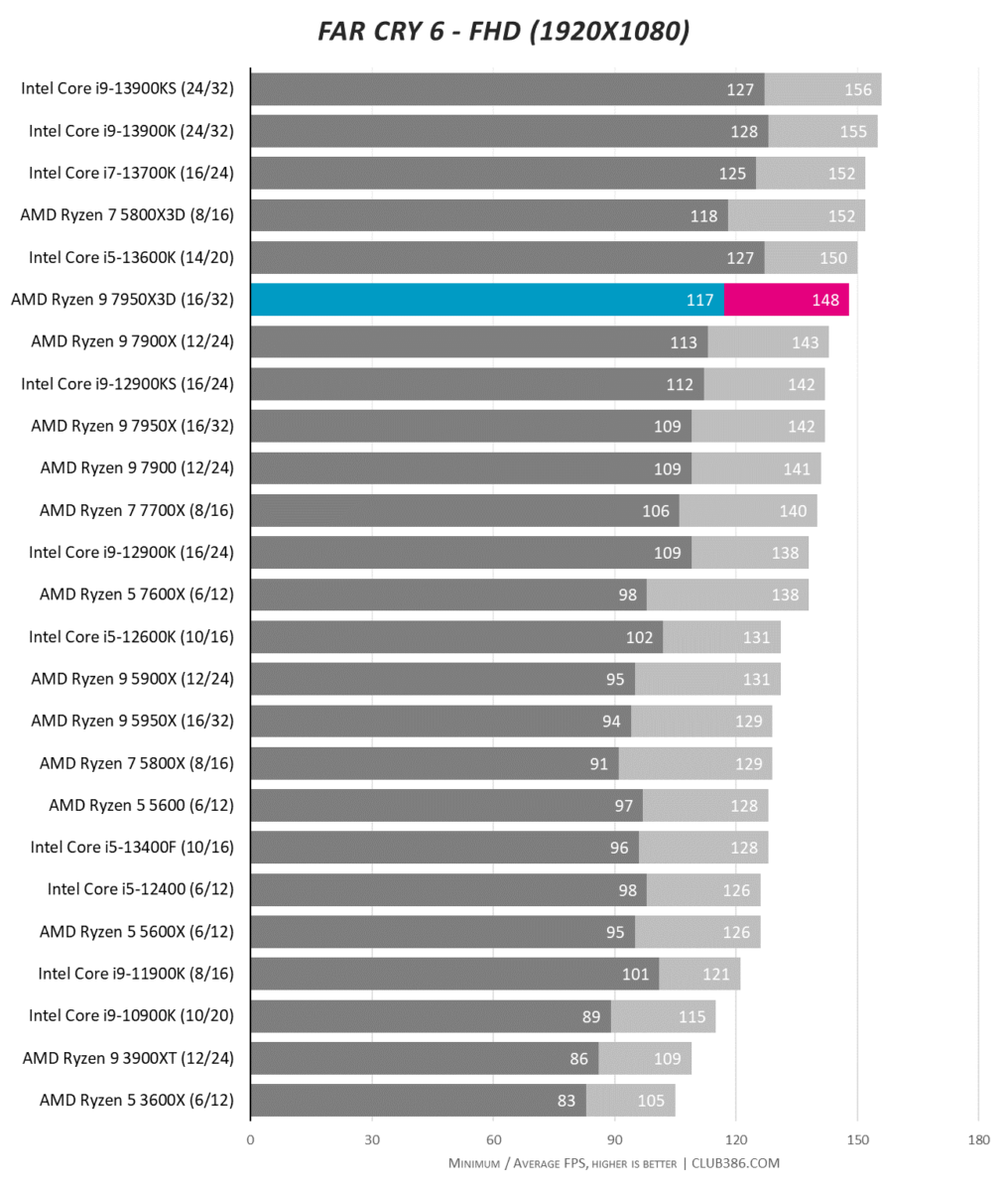
Not the start we had expected. After numerous runs, we couldn’t get 7950X3D past the scores recorded by single-CCD 5800X3D. Multiple Intel chips are faster, too, and perusing AMD’s supporting documentation shows X3D a fair bit slower than rival Intel Core i9-13900KS.
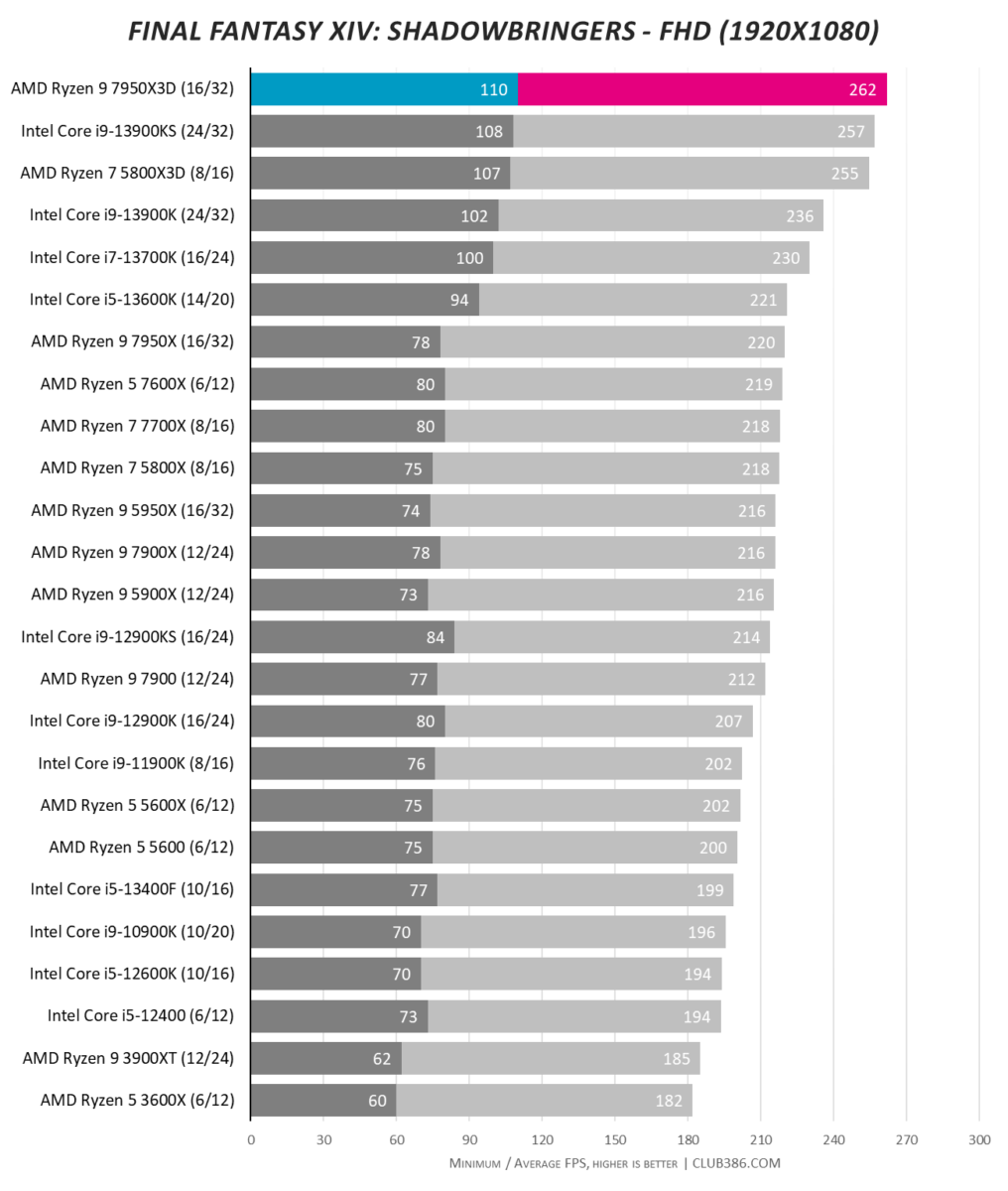
Whaddya know, some games favour lots of cache. Catapulting to the top of the charts in no uncertain fashion, X3D technology can work really well.
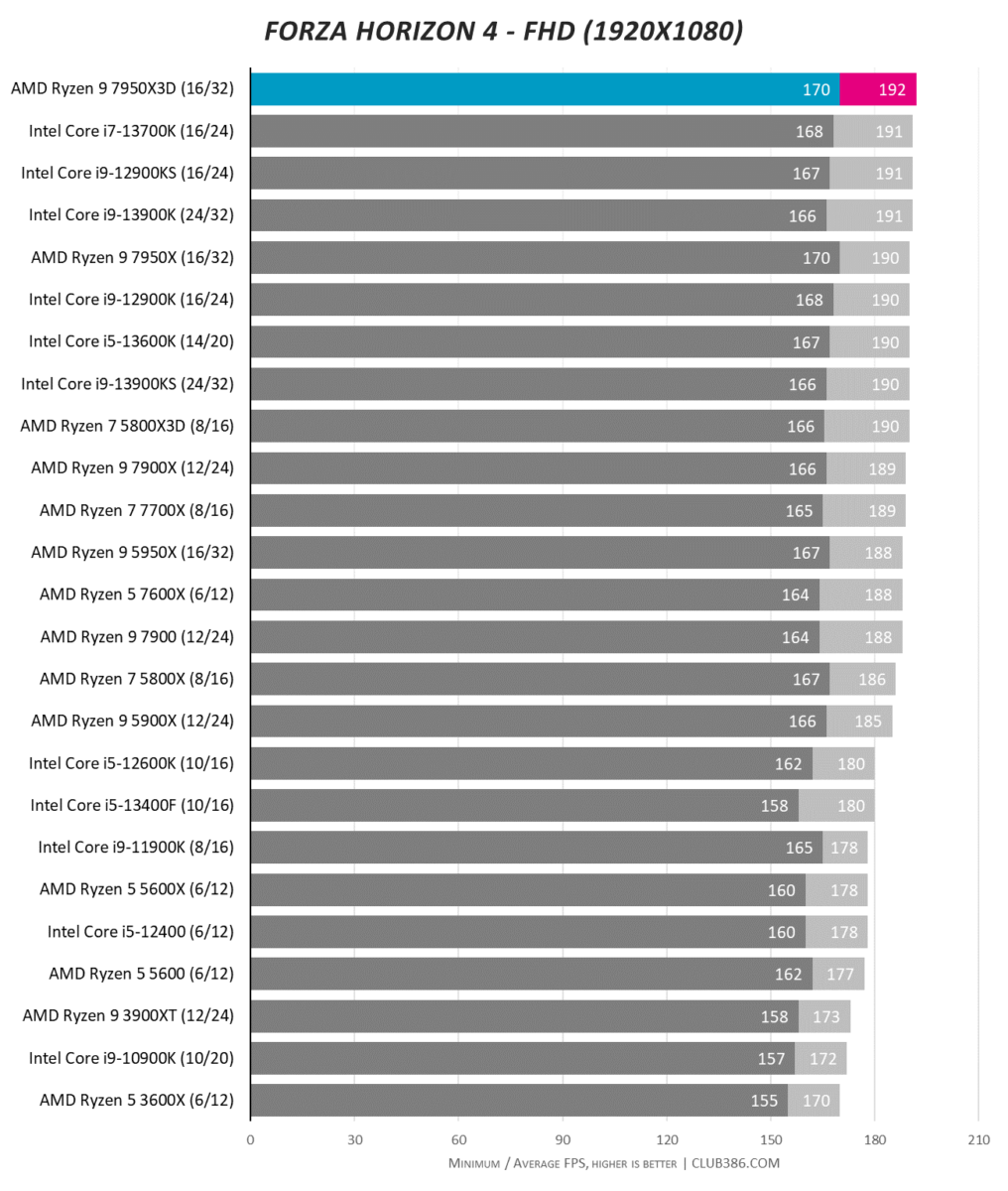
You won’t be able to split the first dozen processors when playing this game, but it sure feels good knowing you have the best CPU for the job.
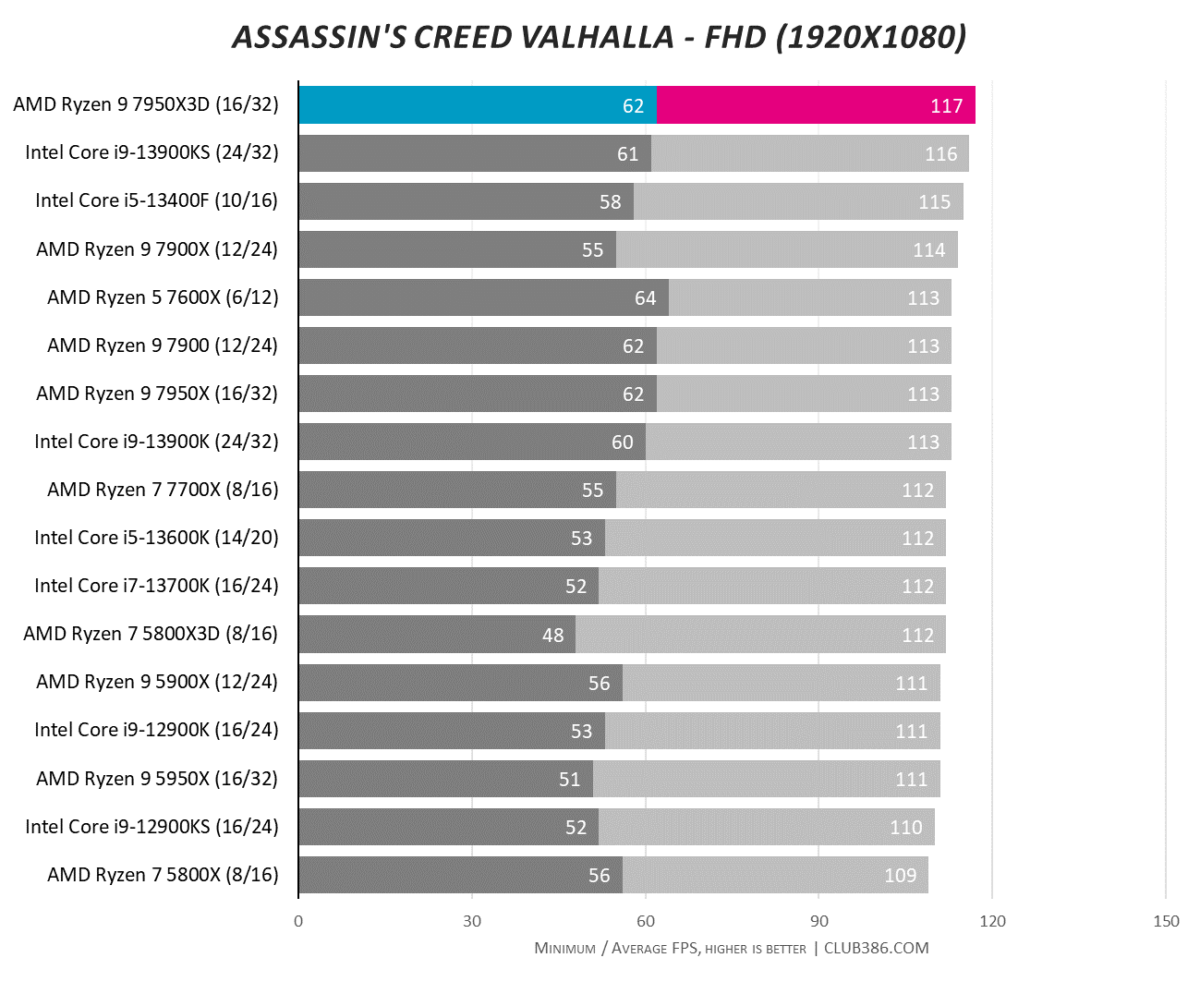
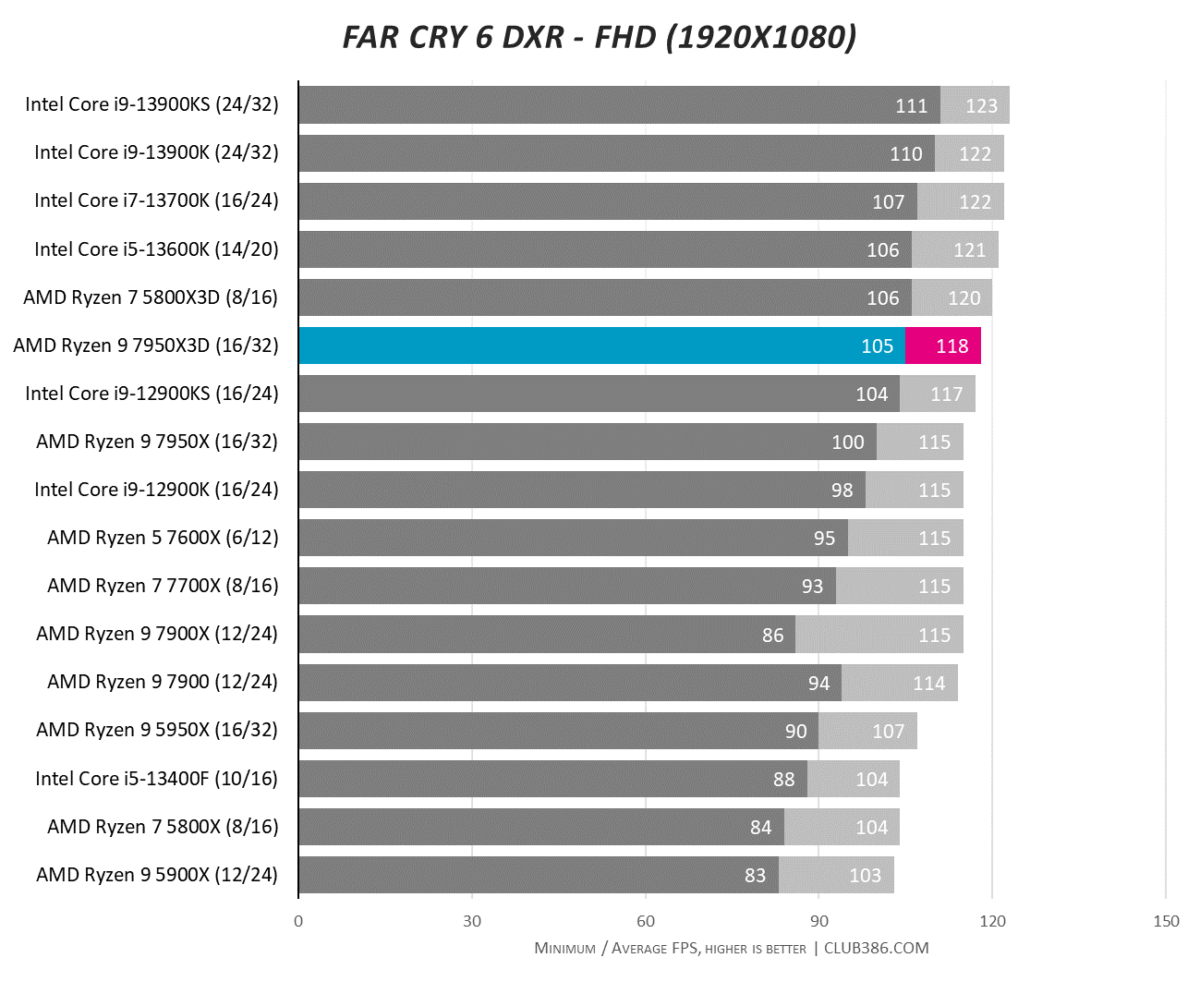
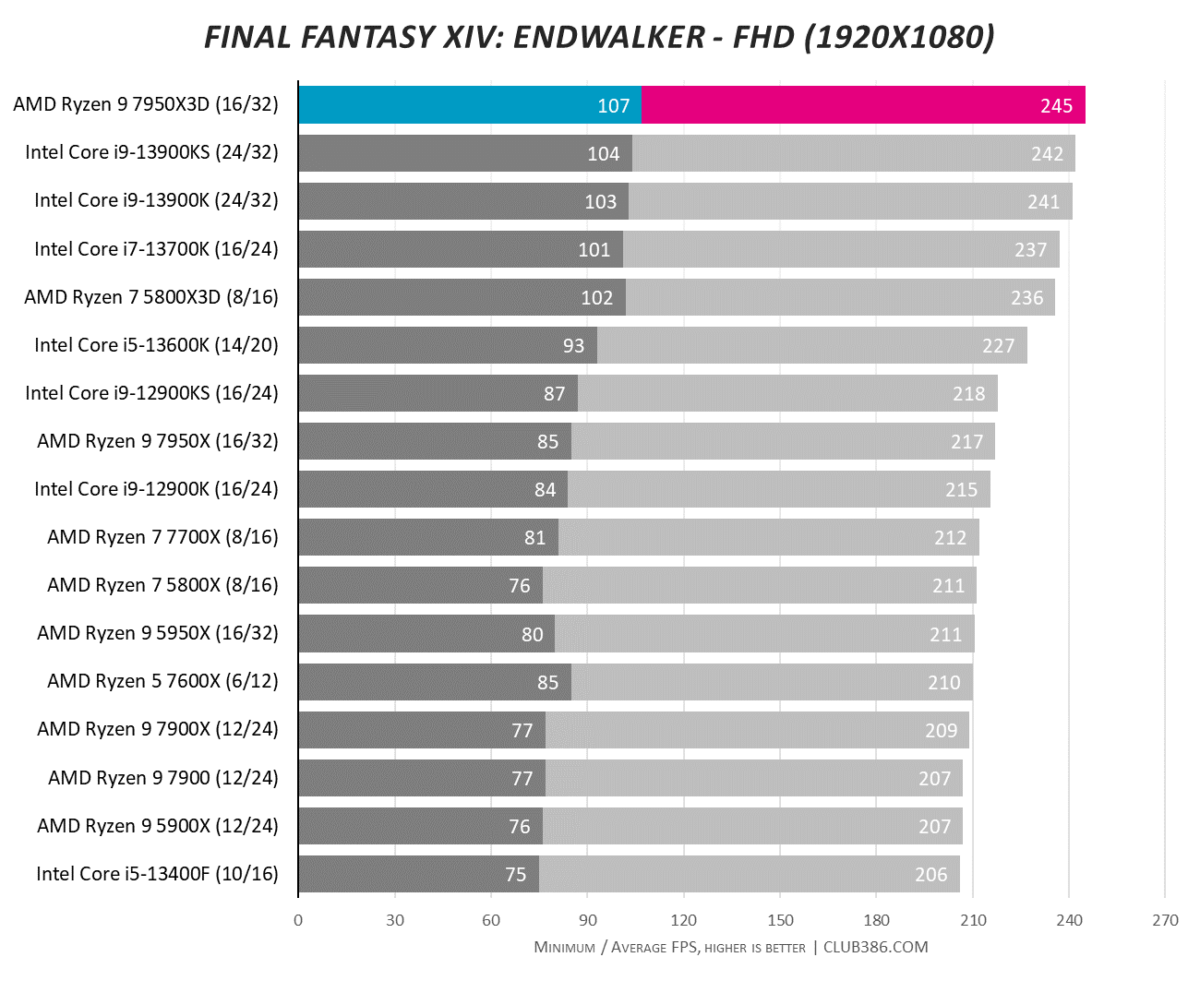
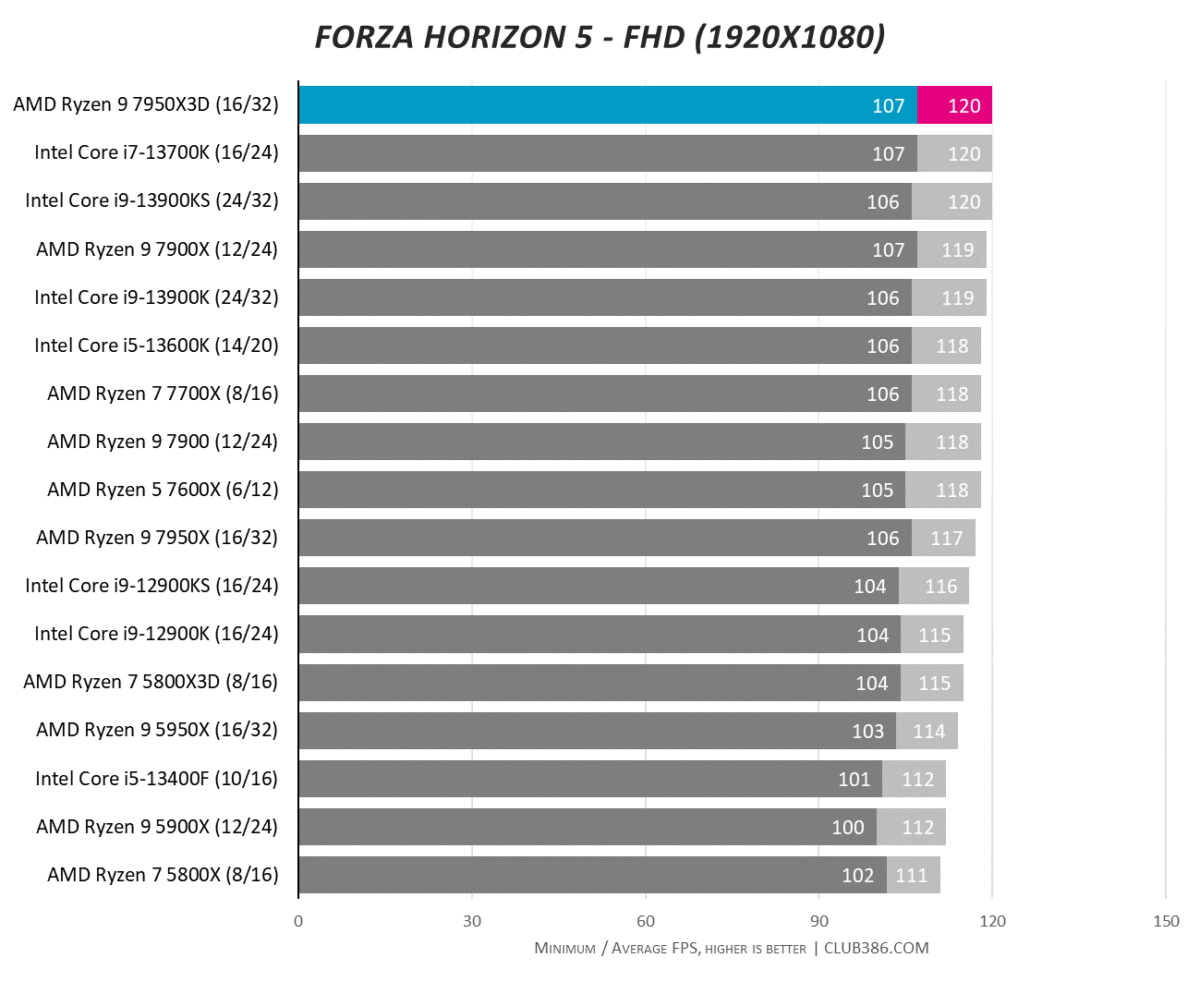
Looking into further games reveals 7950X3D doesn’t have the benchmark wow factor of 5800X3D. That’s because Intel’s latest Raptor Lake architecture has moved the gaming needle to the right, limiting X3D’s comparative gains.
Neither camp can claim outright victory, yet both the Core i9-13900KS and Ryzen 9 7950X3D challenge for gaming supremacy through unique methods. Intel goes for maximum speed, while AMD’s cache-enriched approach favours innovation over brute strength. We know which we prefer.
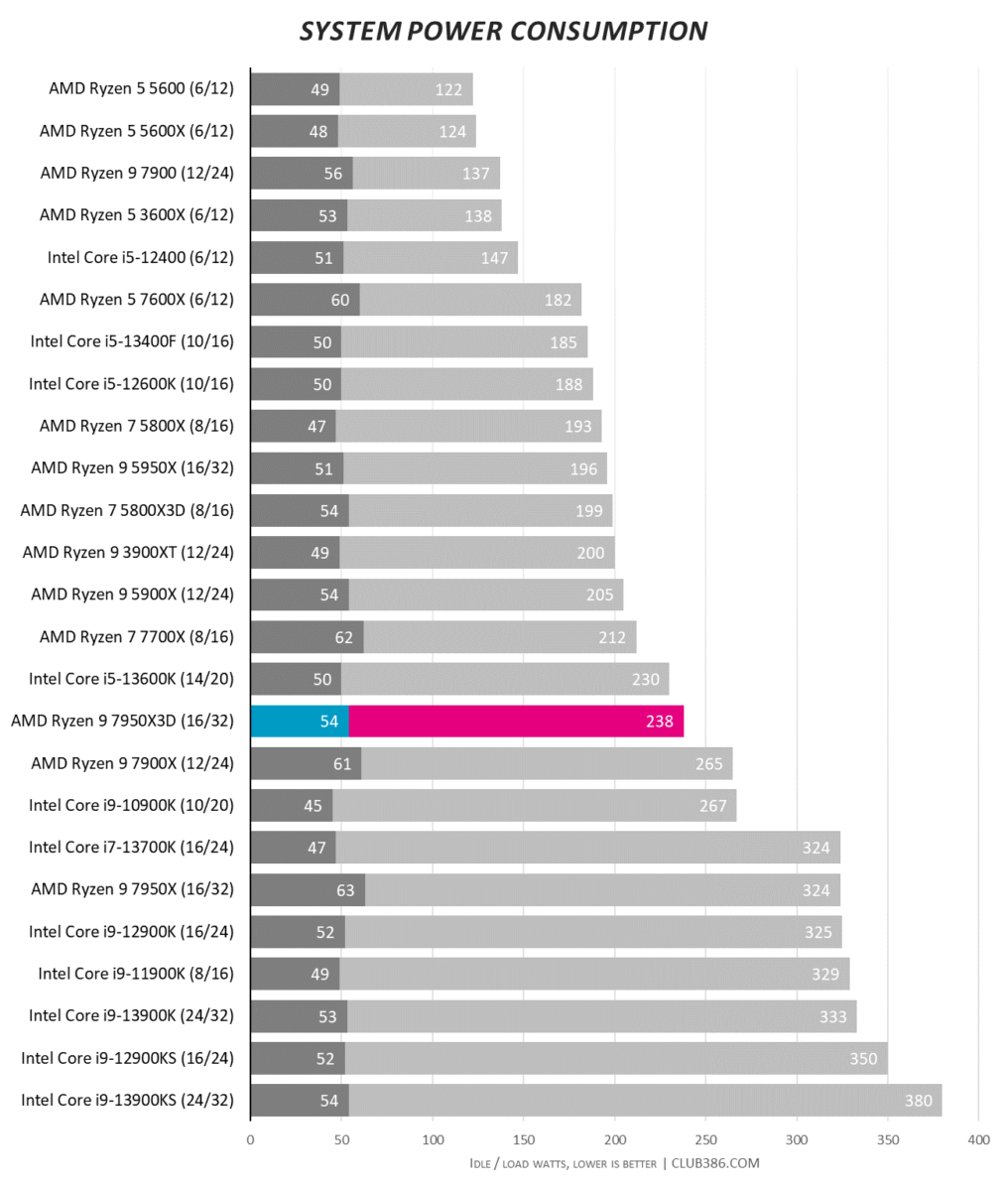
This graph is helpful in pushing up efficiency; do recall 7950X3D ships with a 120W TDP. Like 7950X regular, we believe AMD ought to have let it run mostly free of wattage constraints – a 170W TDP 7950X3D would certainly benchmark that little bit better… but then what would be the point of 7950X regular? Decisions, decisions.
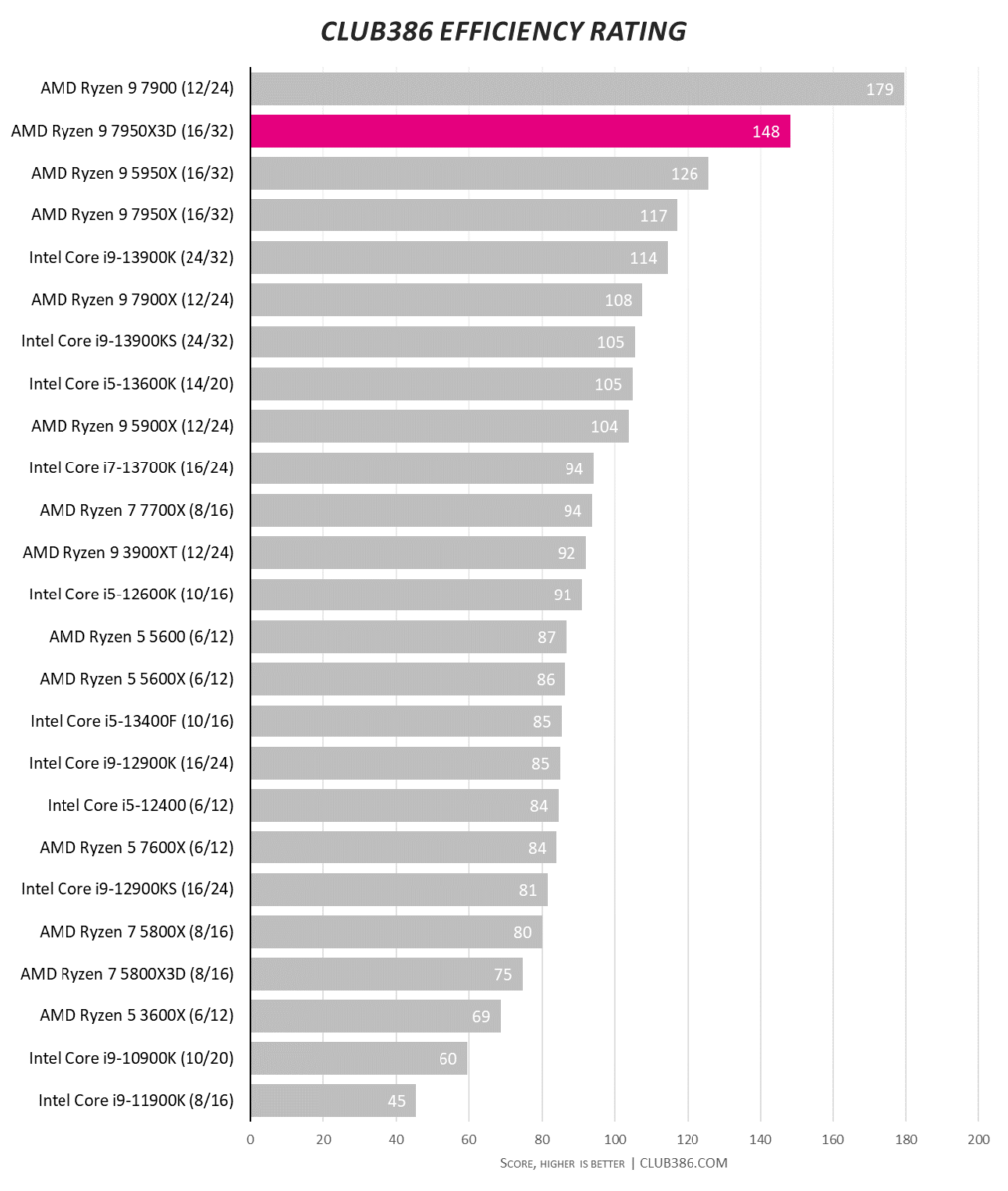
Great multi-thread performance meets a very acceptable TDP. Result is a high placing on this graph which divides the multi-core Cinebench score by system-wide power consumption.
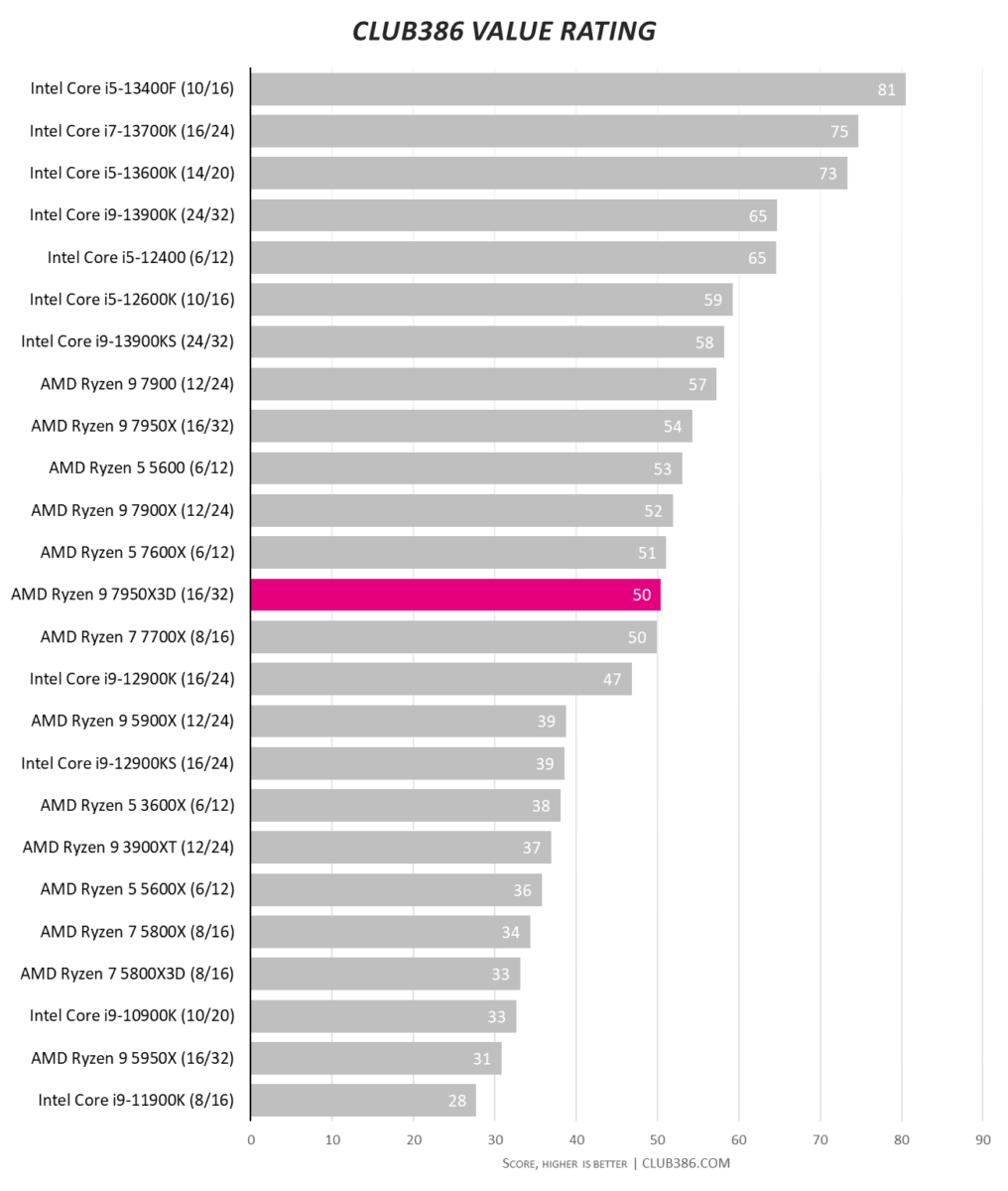
Derived by dividing the same multi-core score by recommended pricing, value, too, is okay given how much application and gaming performance is on offer.
Conclusion
The emergence of Zen 4-based desktop CPUs late last year paved the way for X3D models to follow soon after. AMD has duly delivered on that rollout by releasing three chips touting enhanced cache for improved performance in gaming.
Leveraging the same technology we first witnessed with the impressive Ryzen 7 5800X3D, suffusing more L3 cache is inherently more difficult on two-CCD processors such as the review Ryzen 9 7950X3D and 7900X3D. The asymmetrical design and restrained power budget work well enough to deliver the same level of overall gaming performance as MadWattage™ Core i9-13900KS, which is a feat in itself.
The perfect desktop X3D chip would carry gobs of cache on both CCDs, ratchet up power to 170W, and be heavily overclockable to boot. Ryzen 9 7950X3D isn’t that, but it’s a dame fine processor in its own right.
Verdict: The first X3D technology on a dual-CCD desktop processor proves its gaming mettle against all comers.

